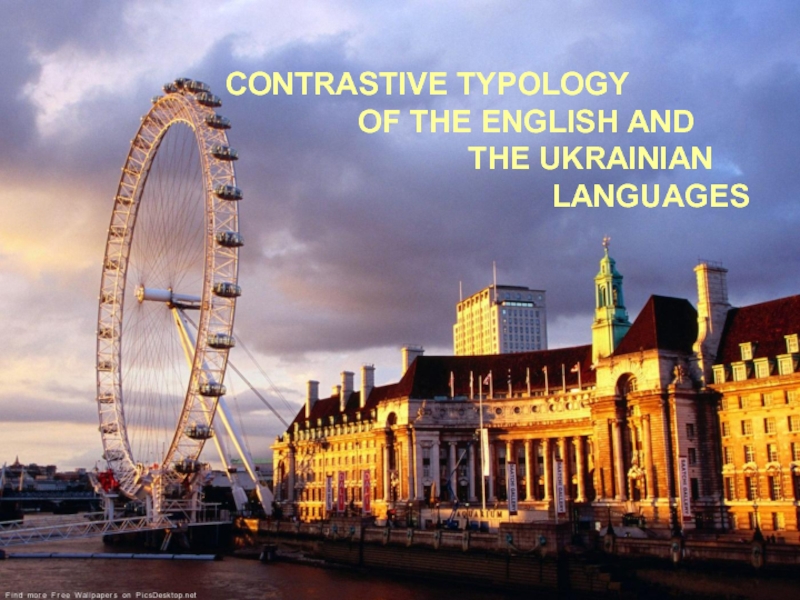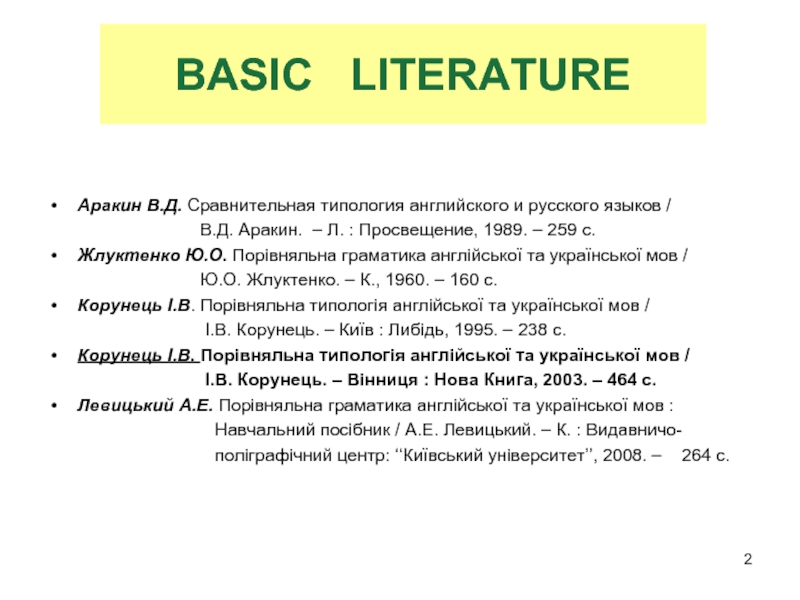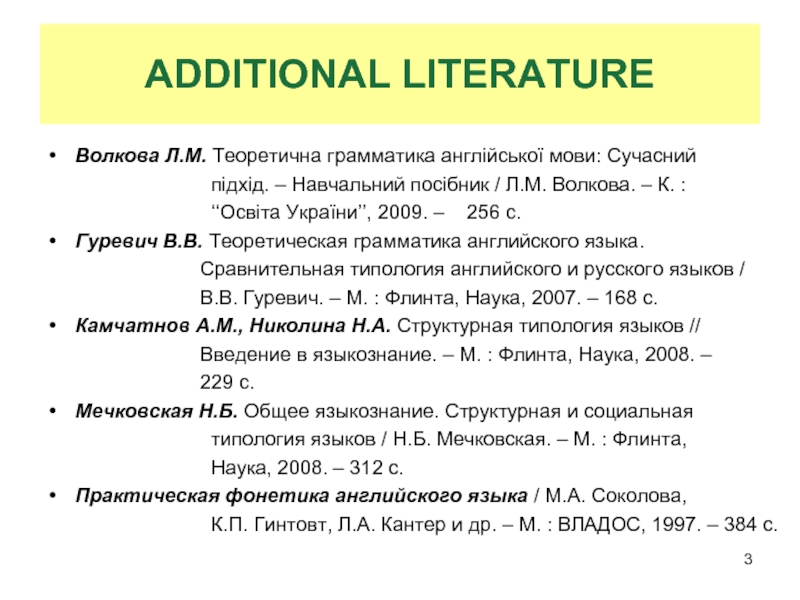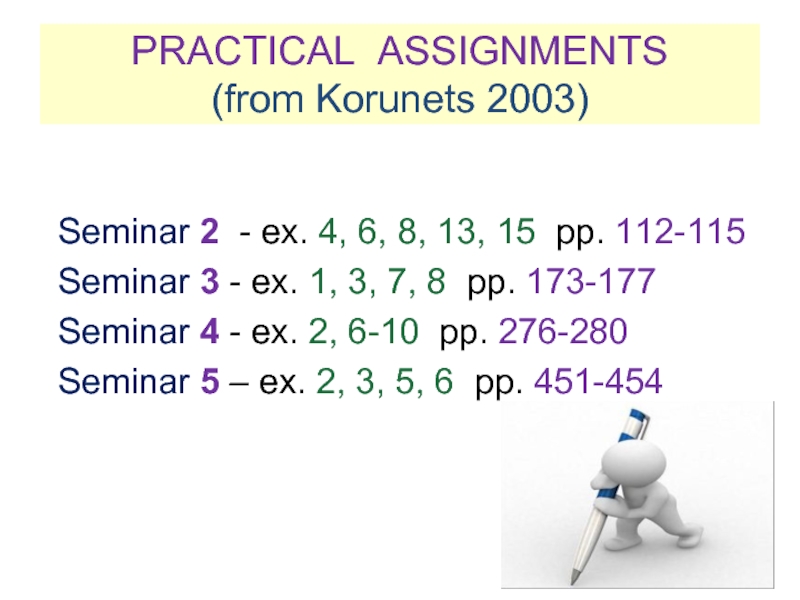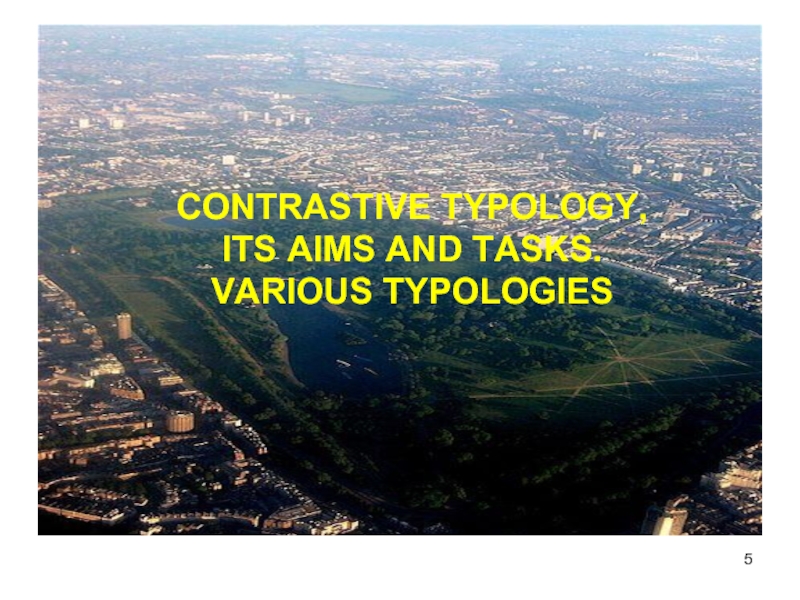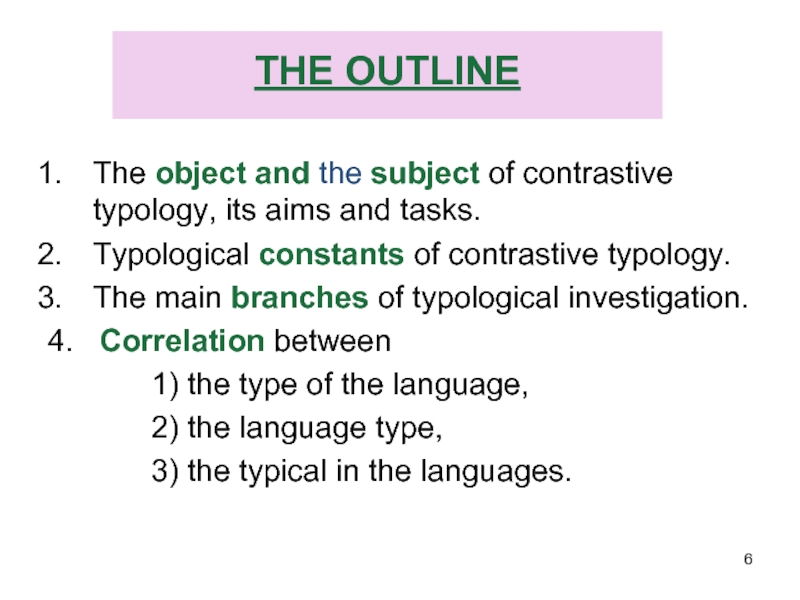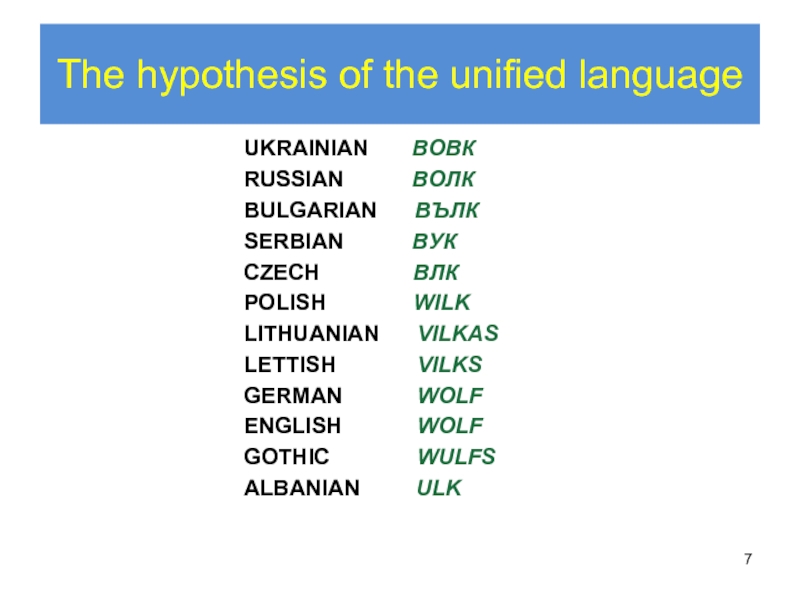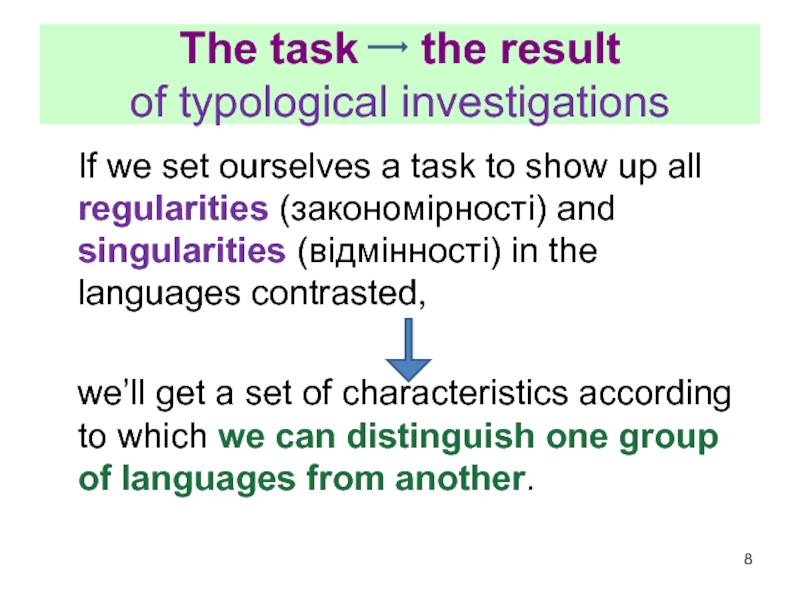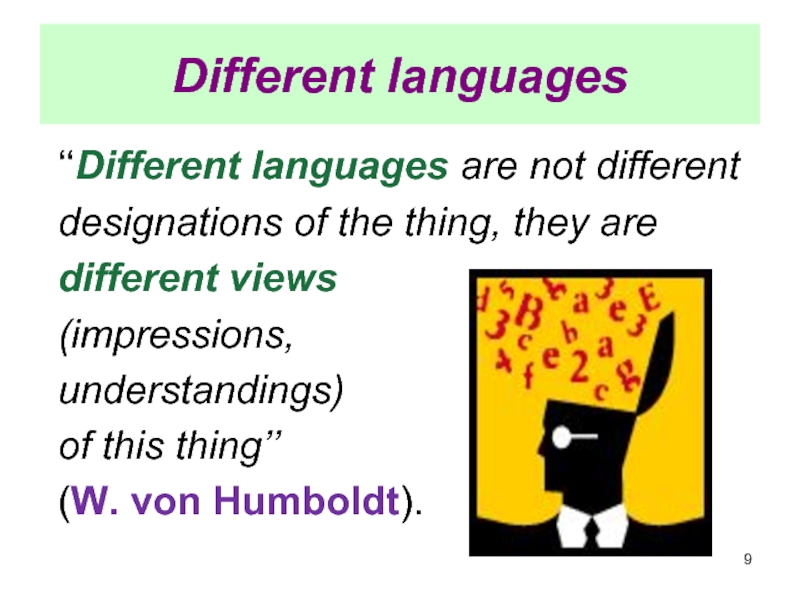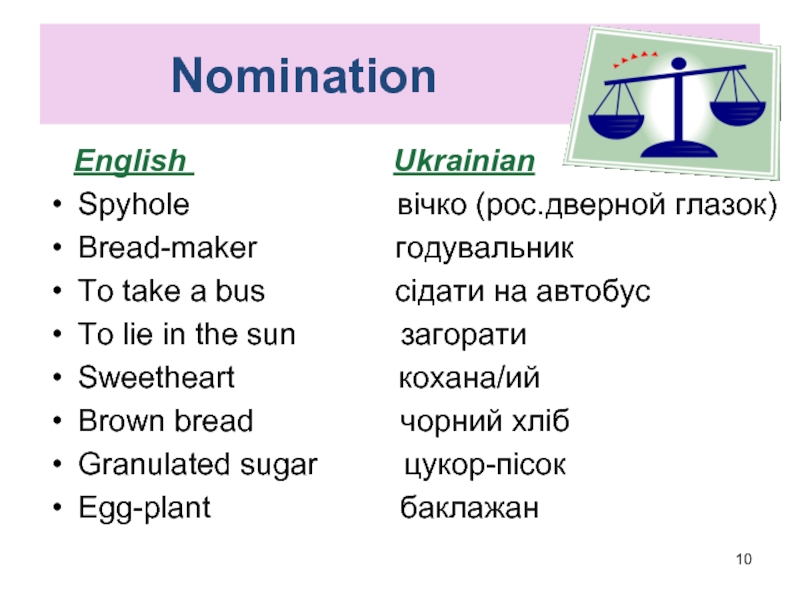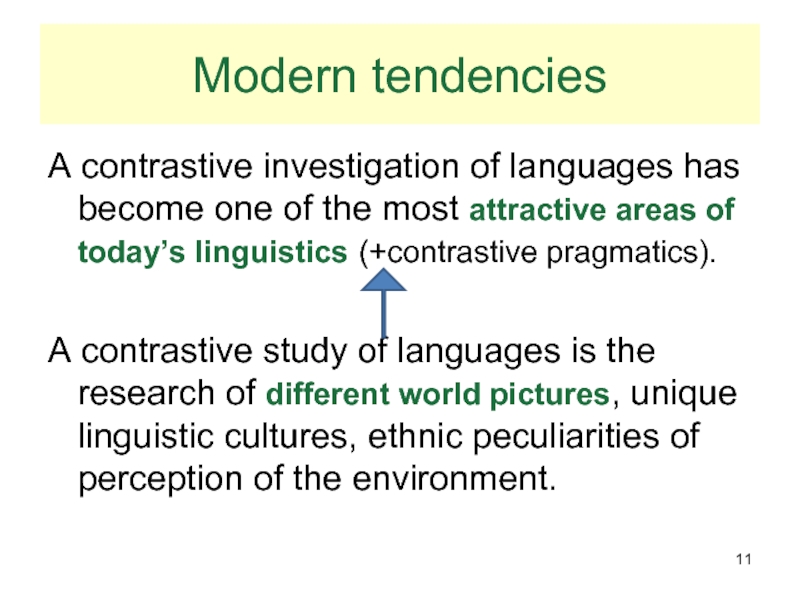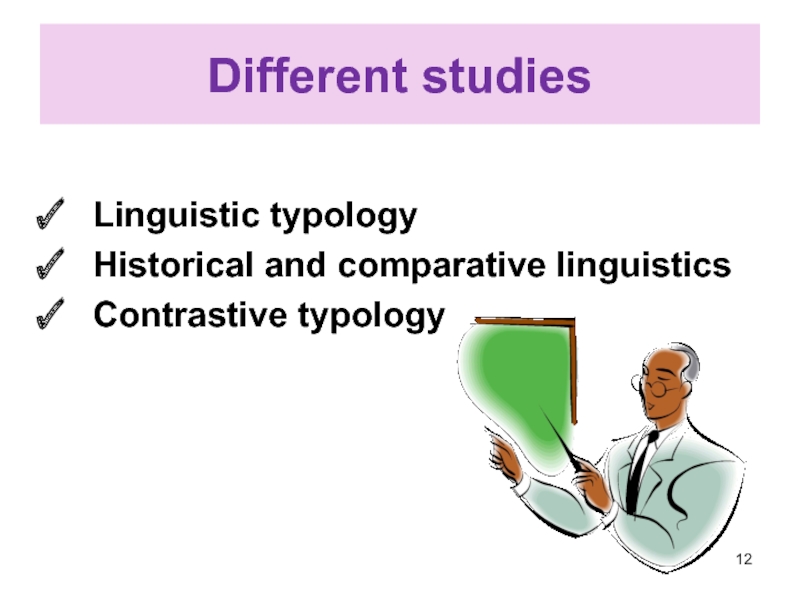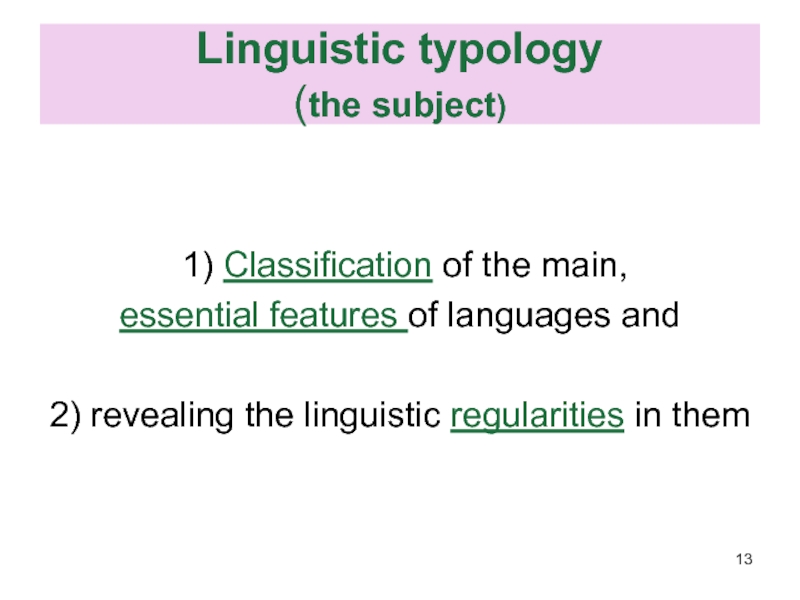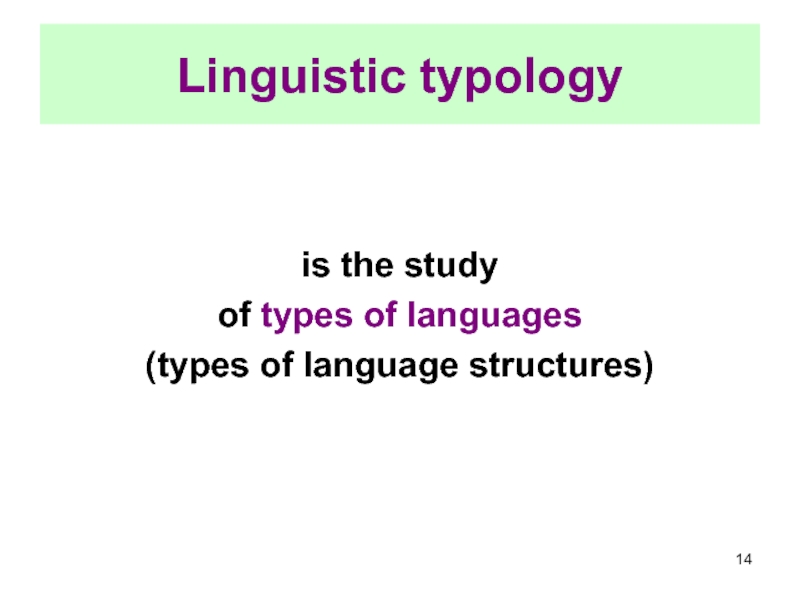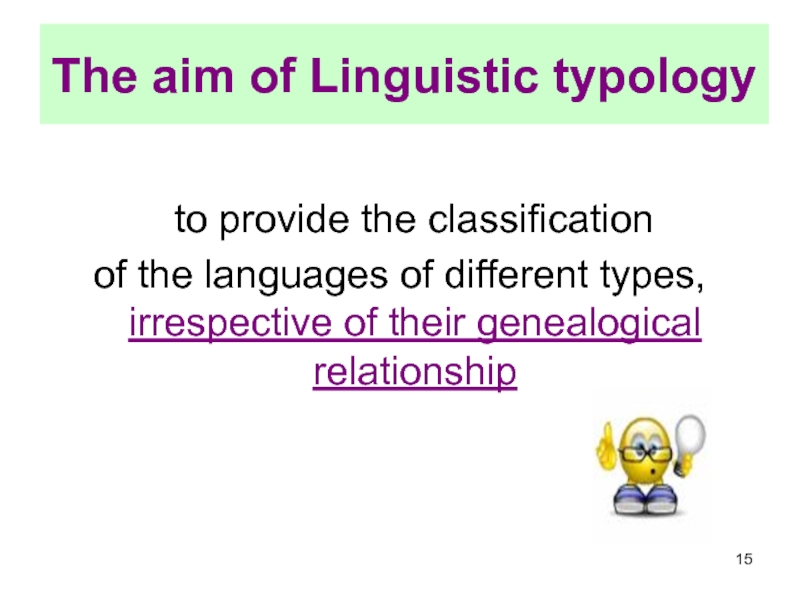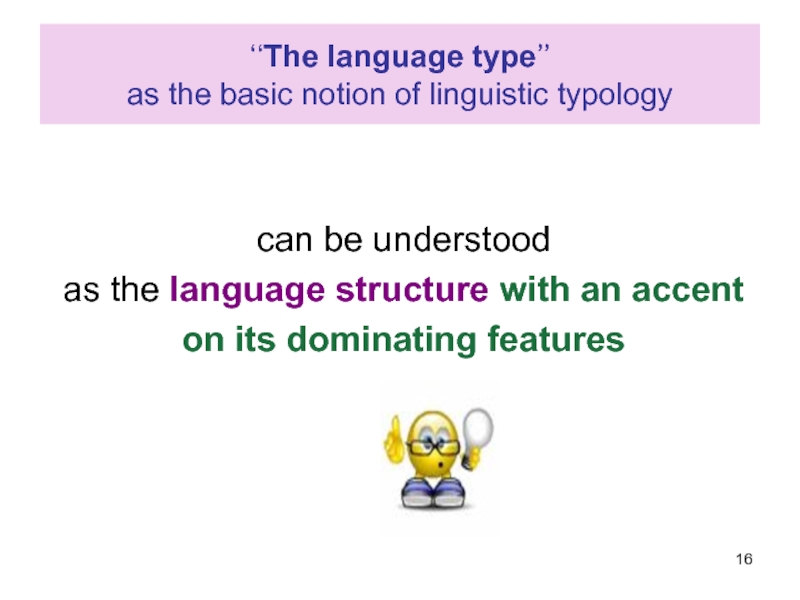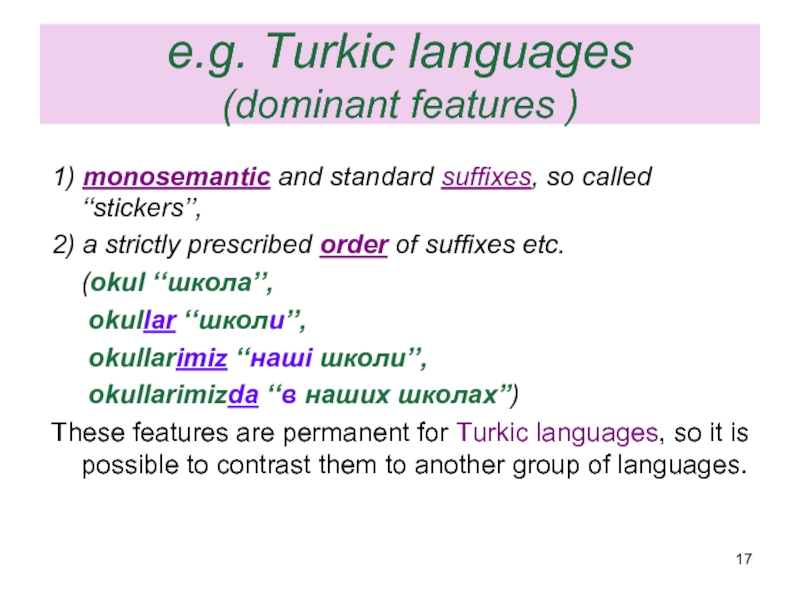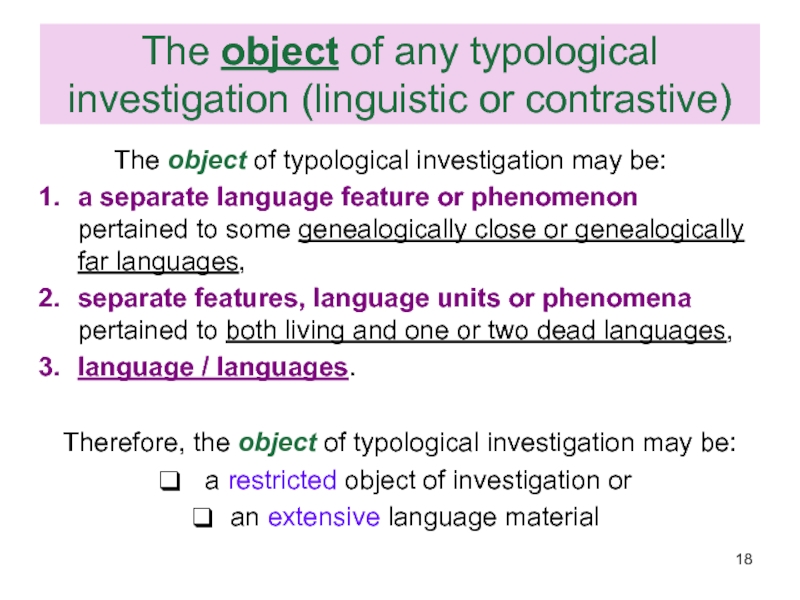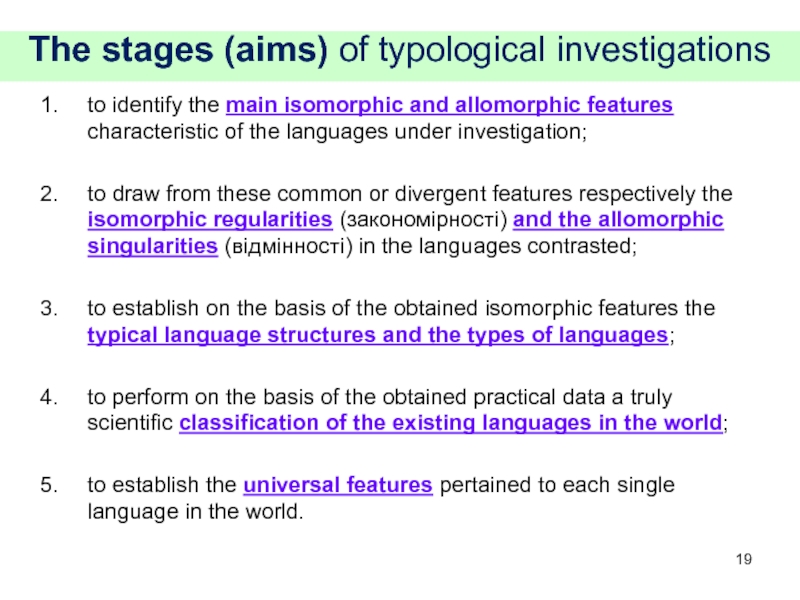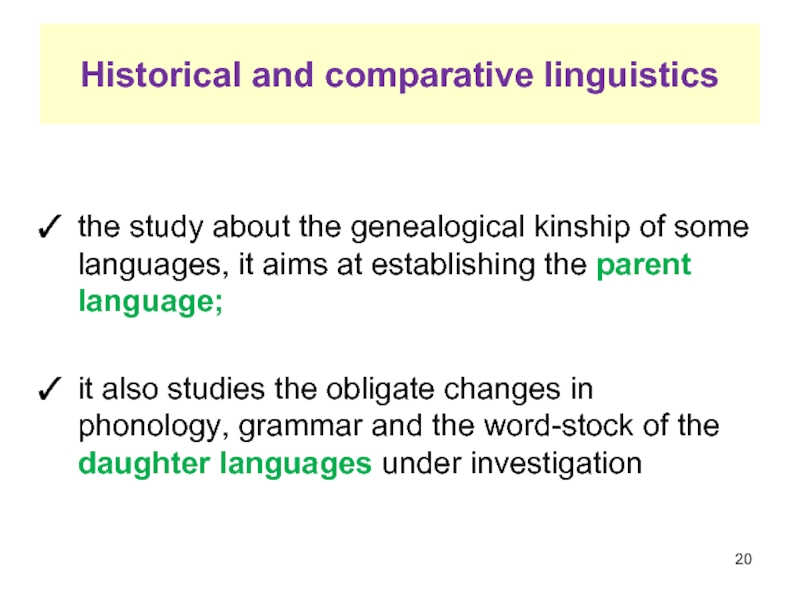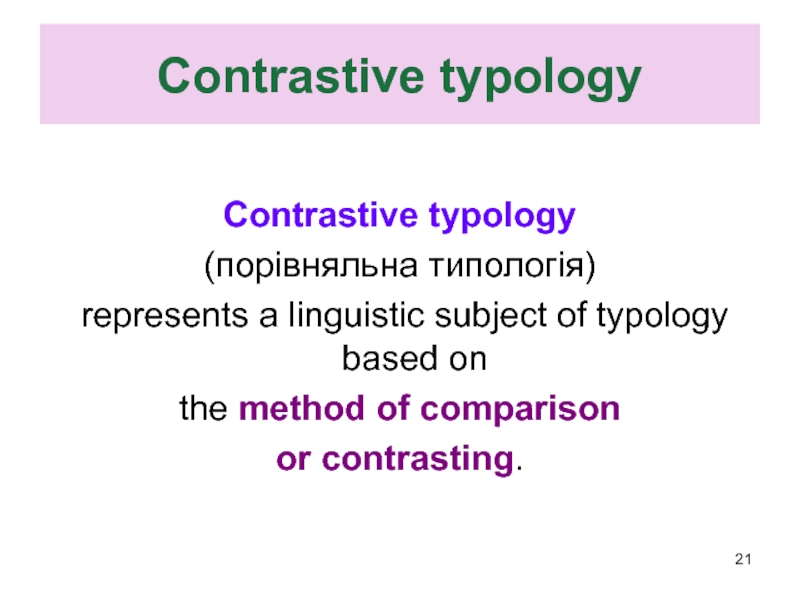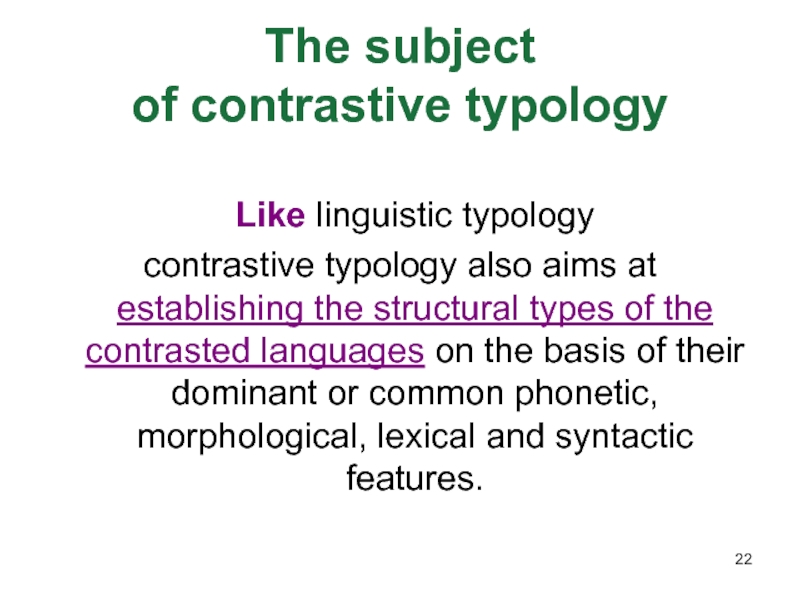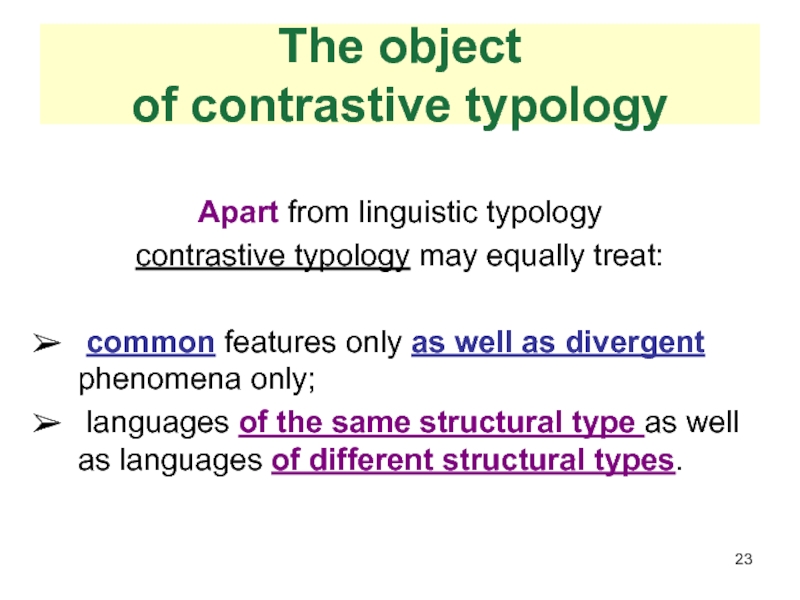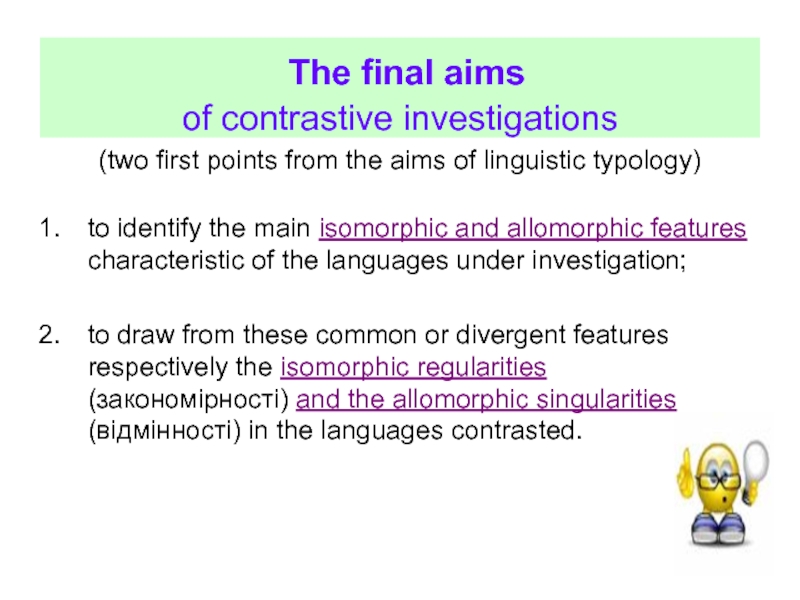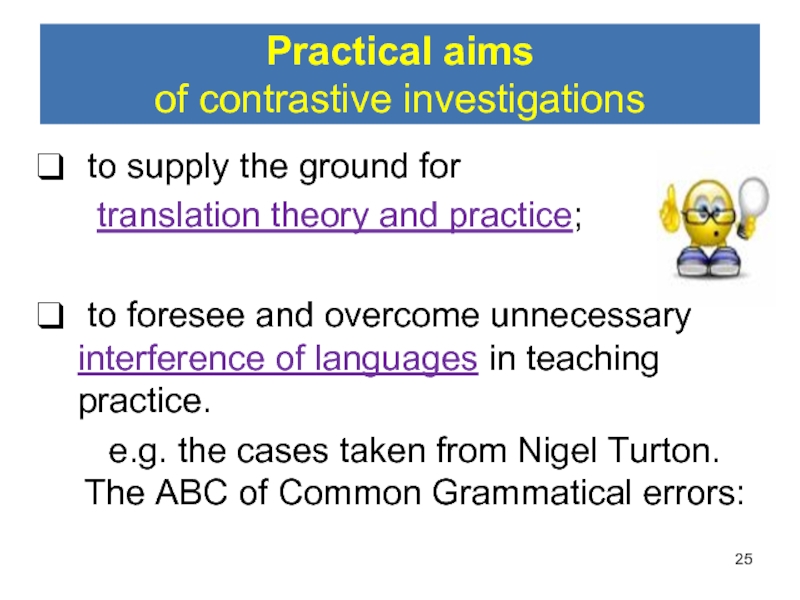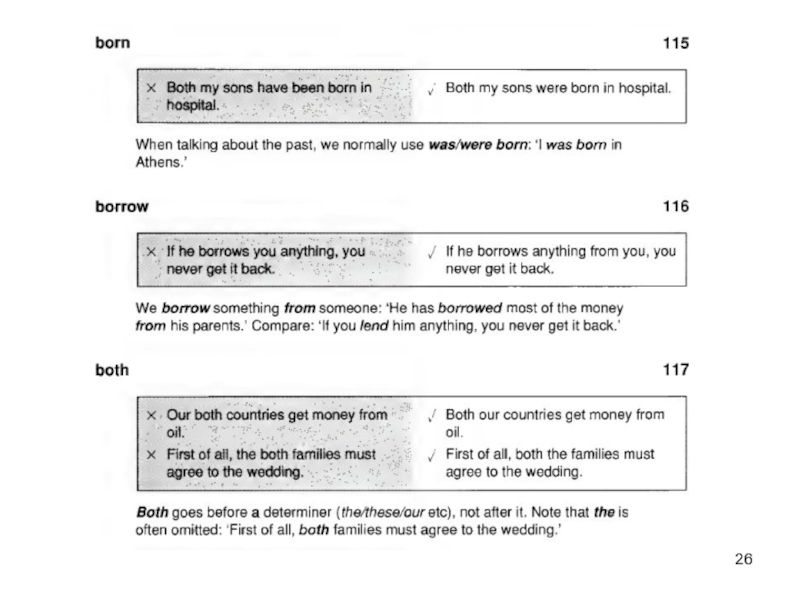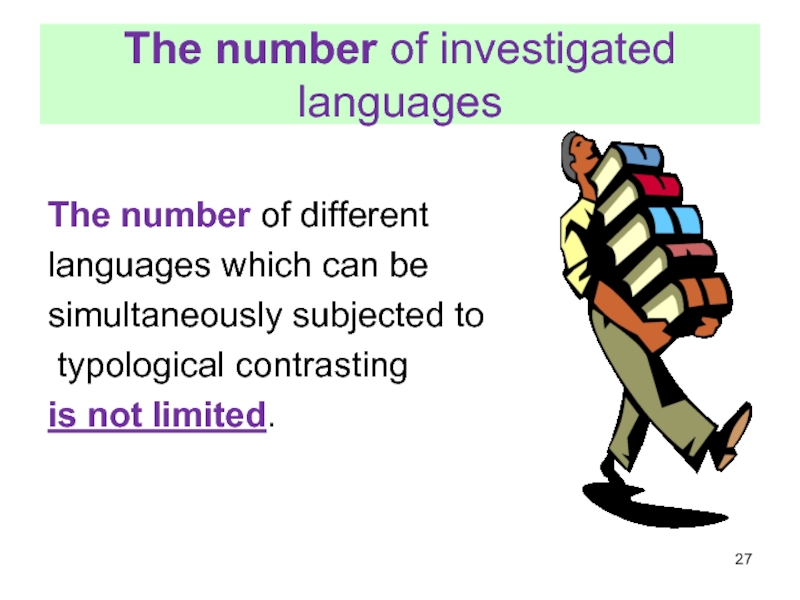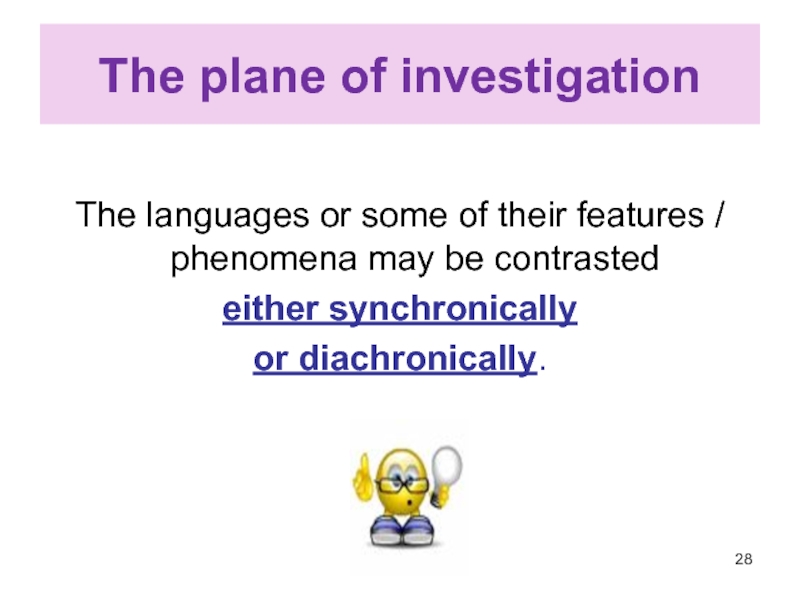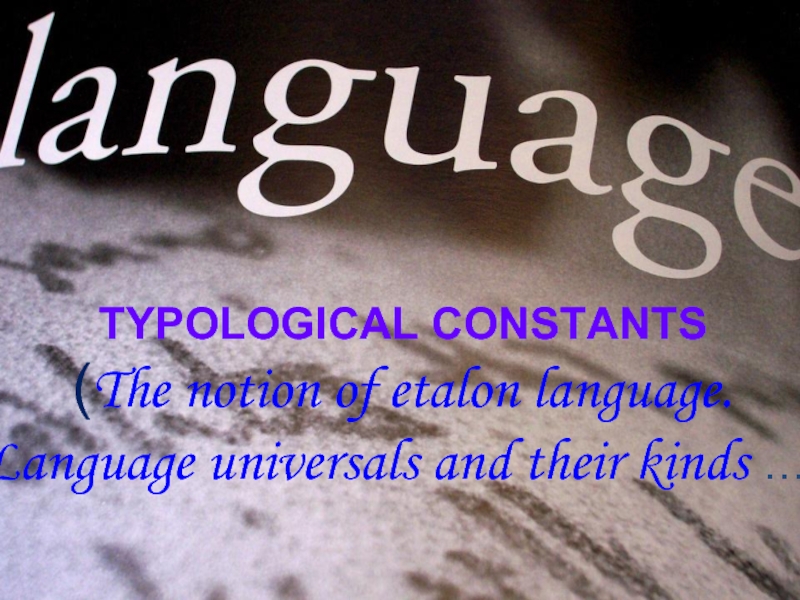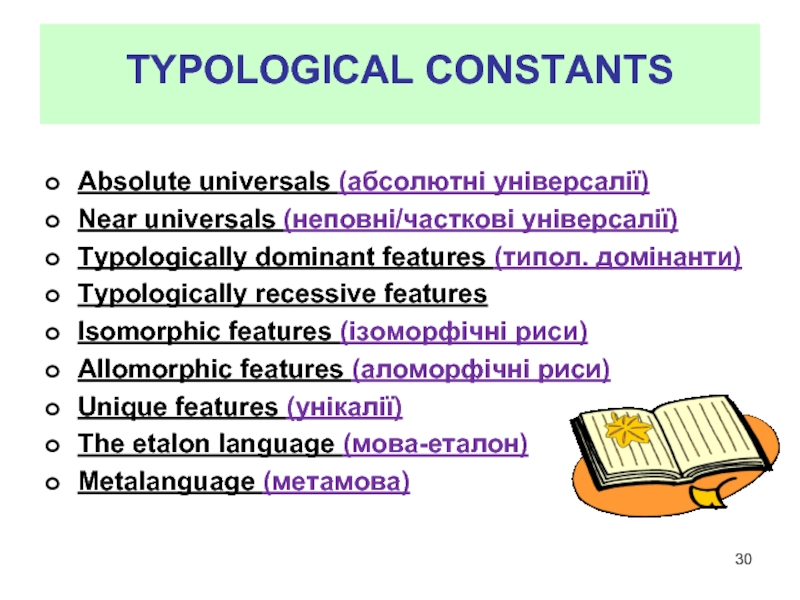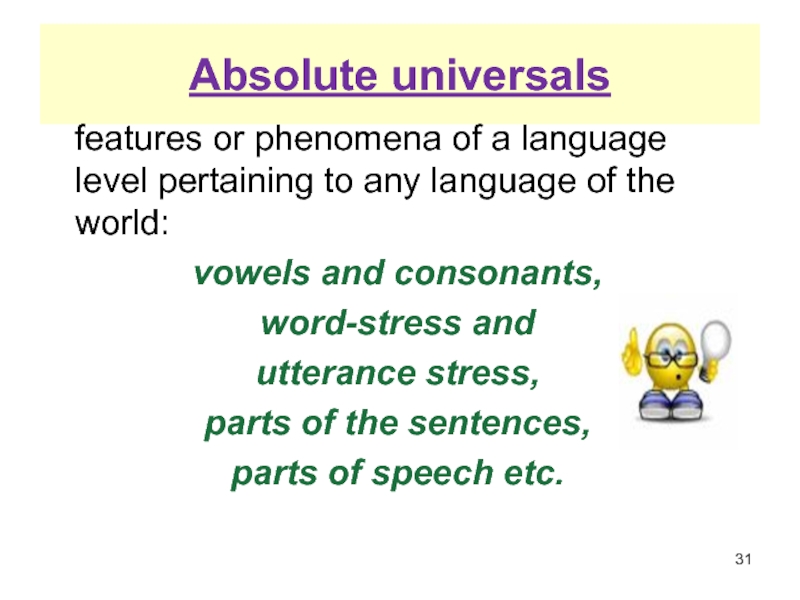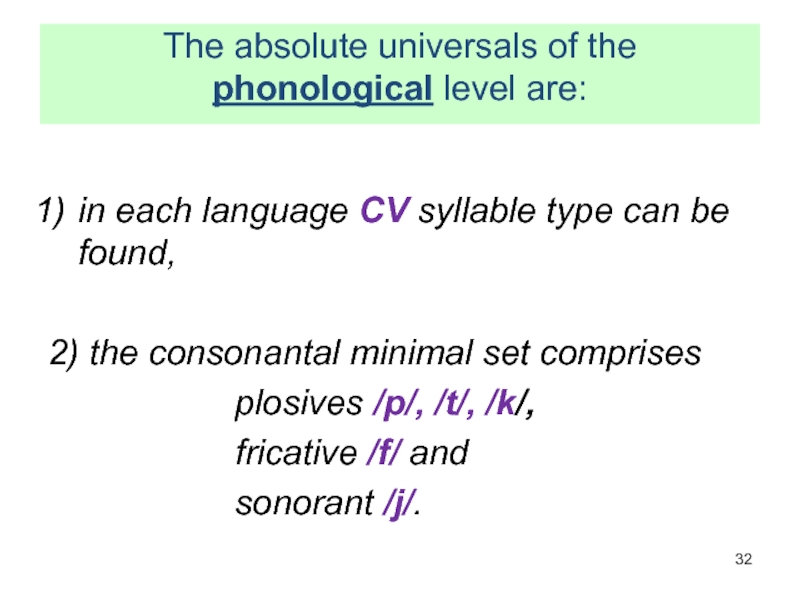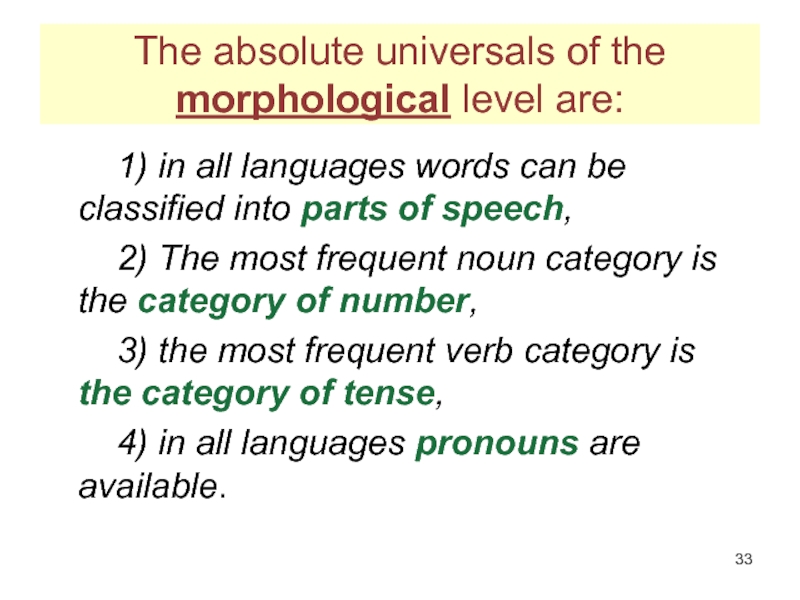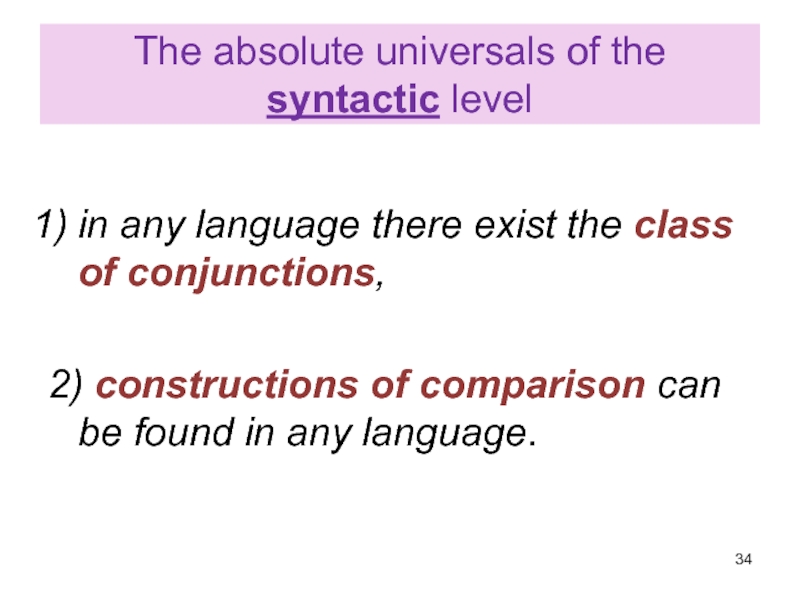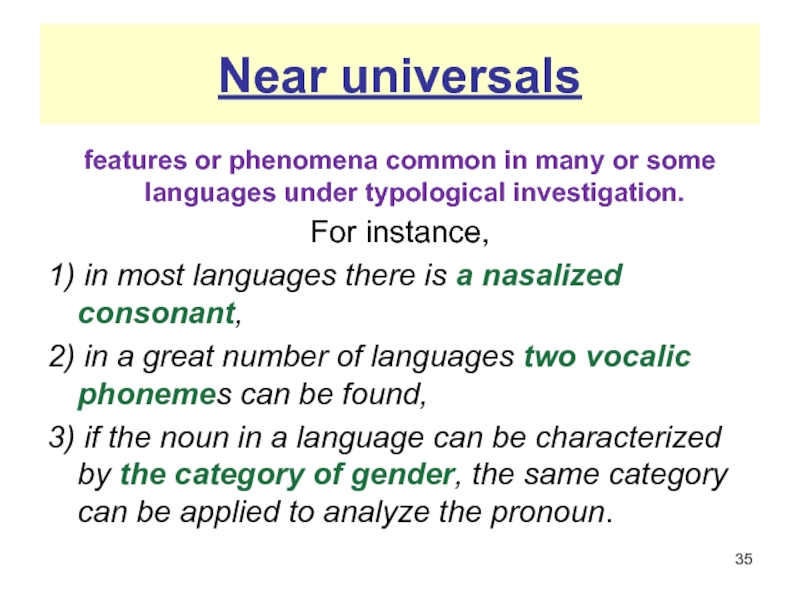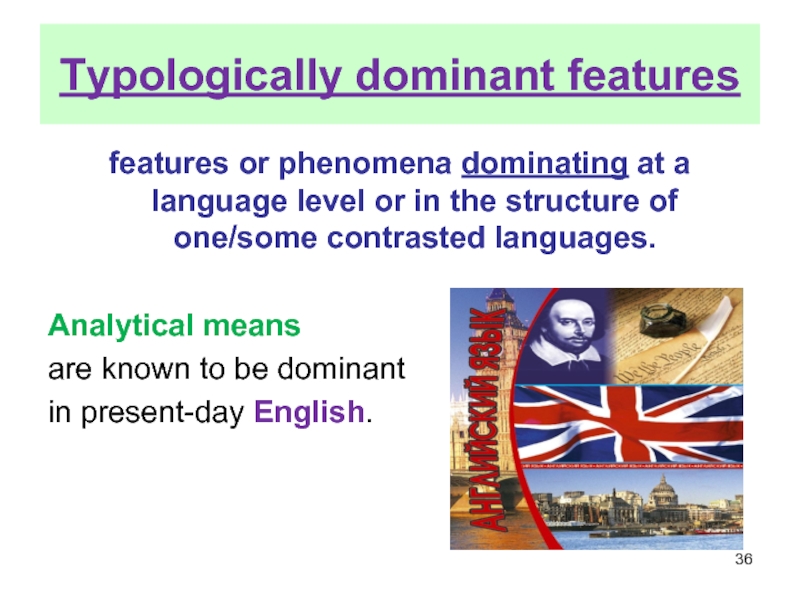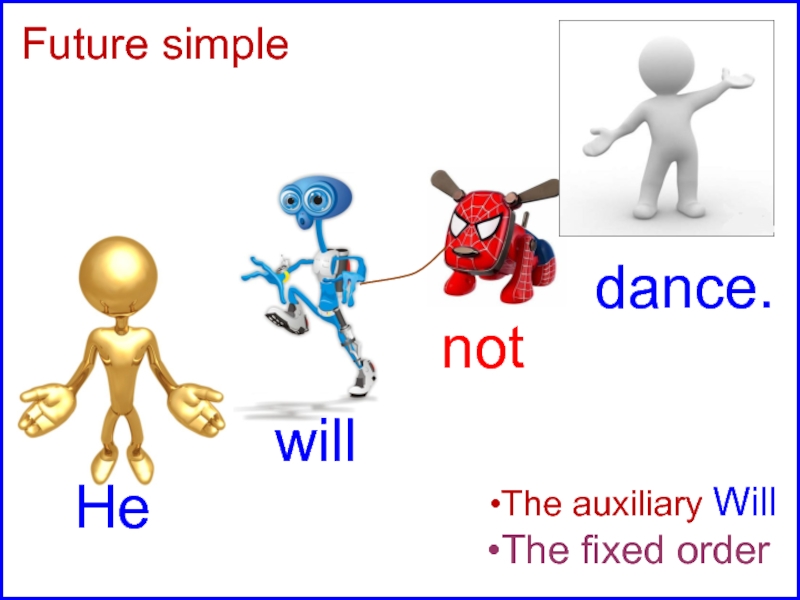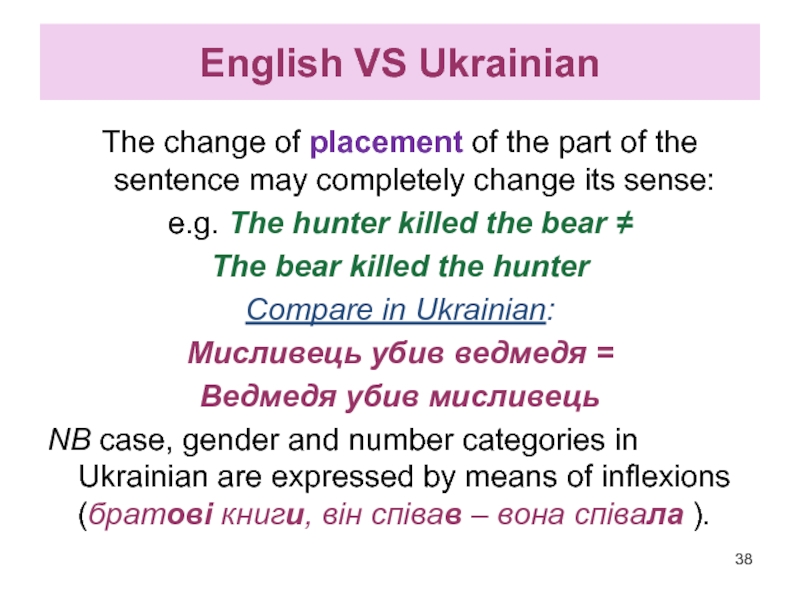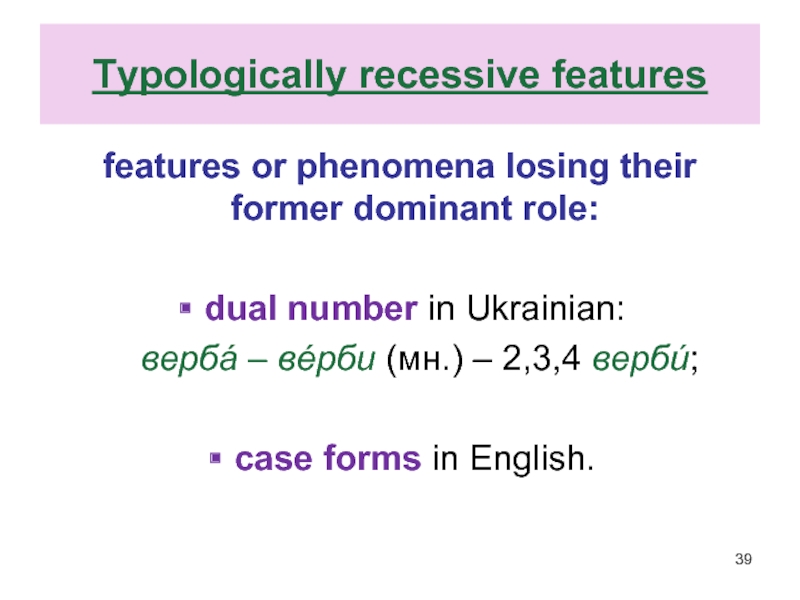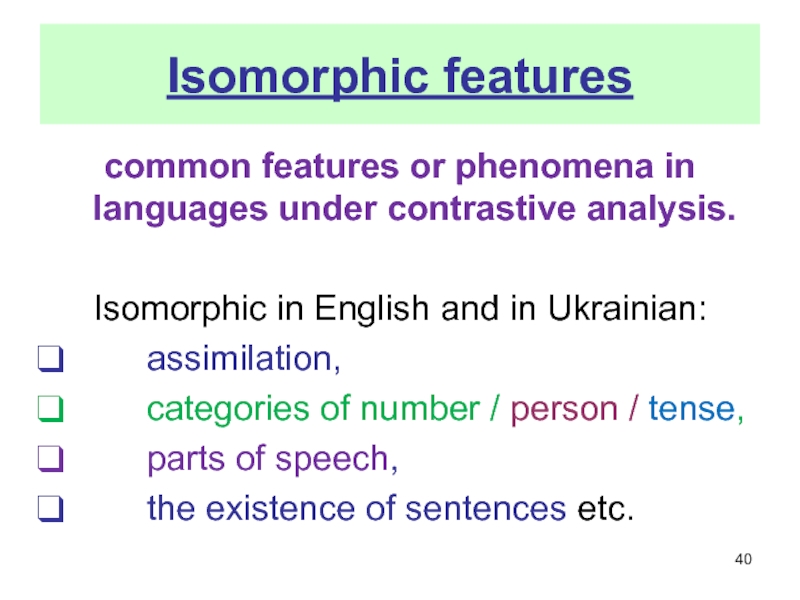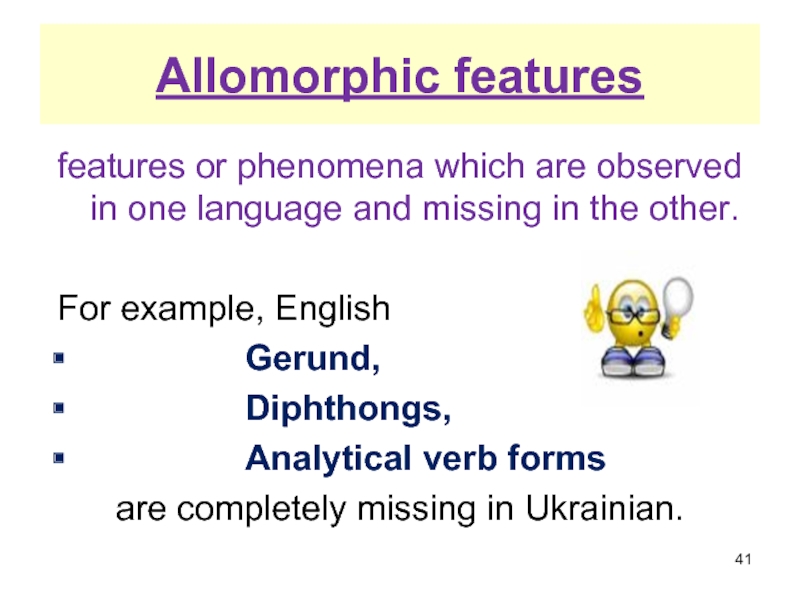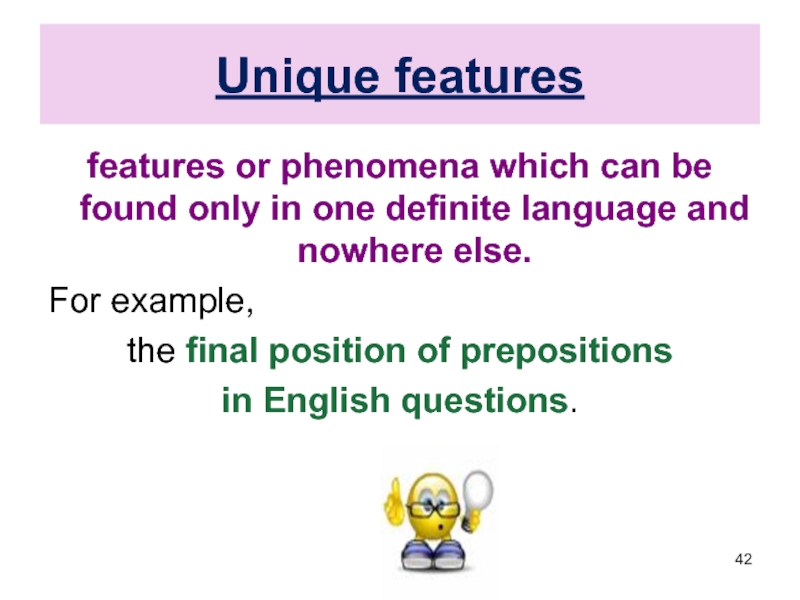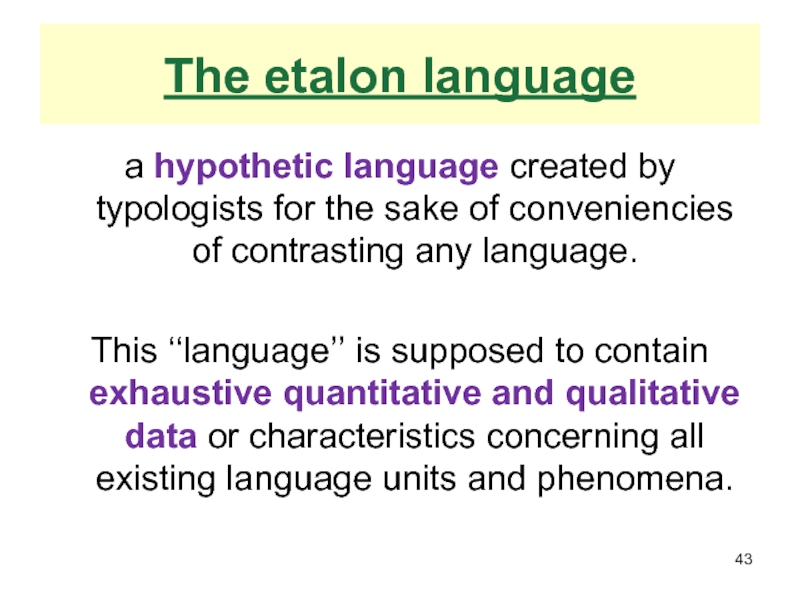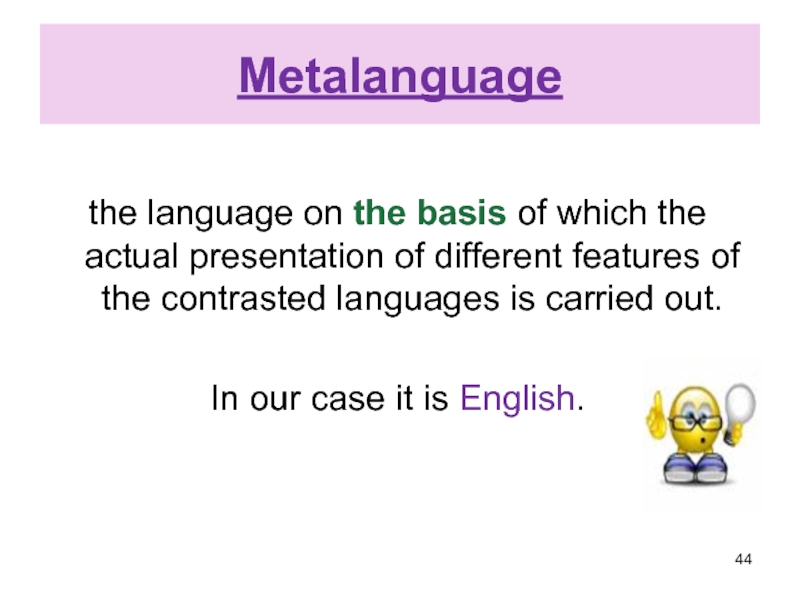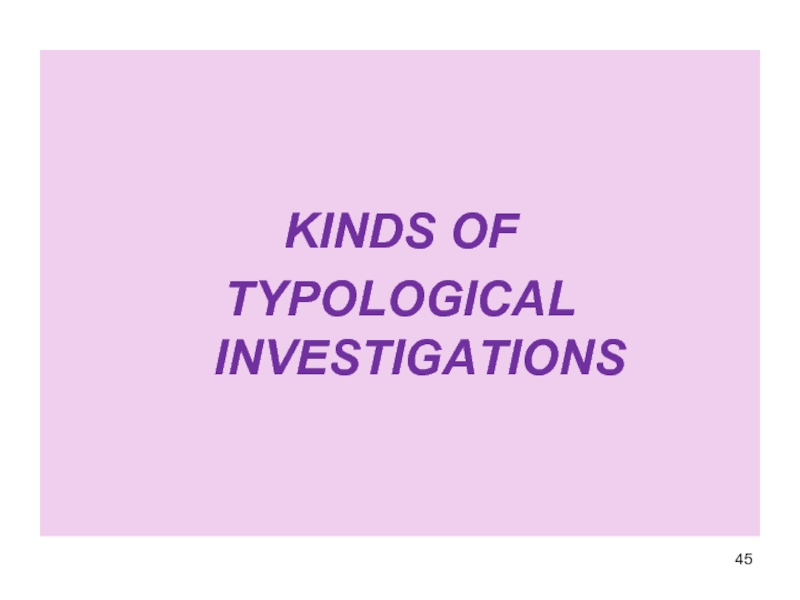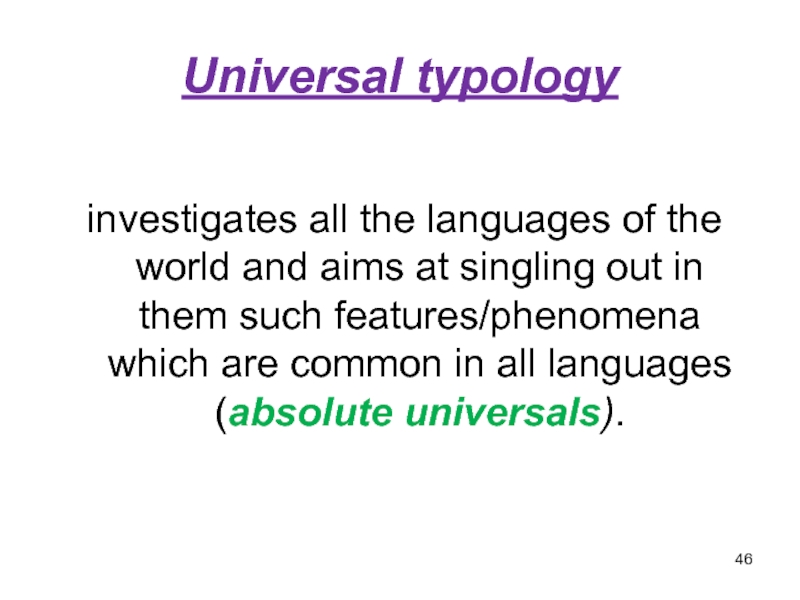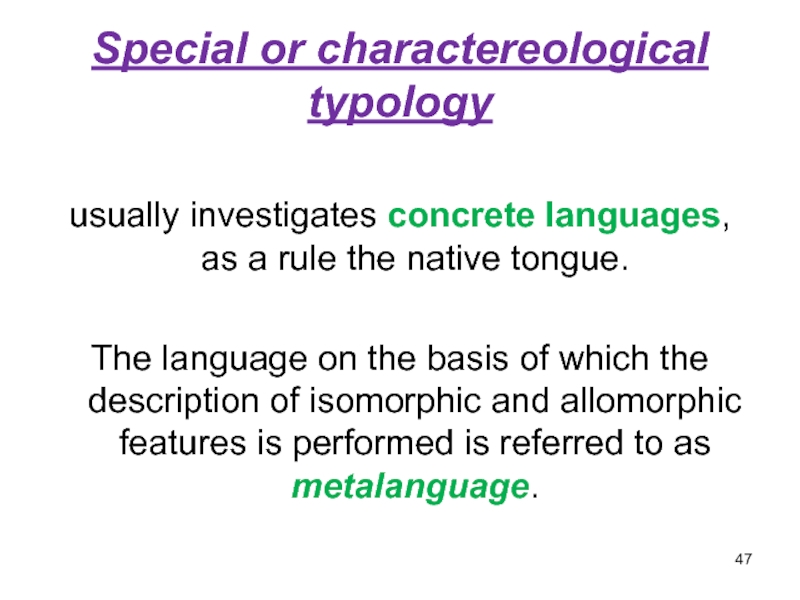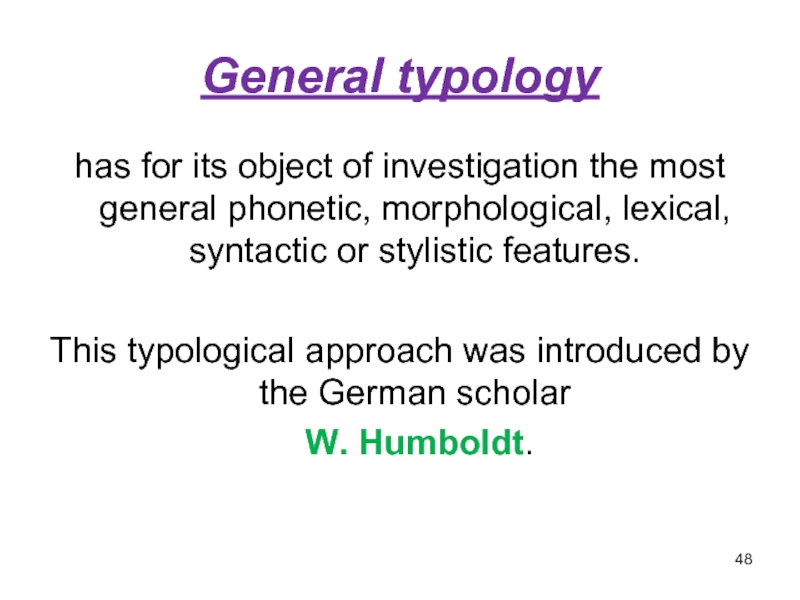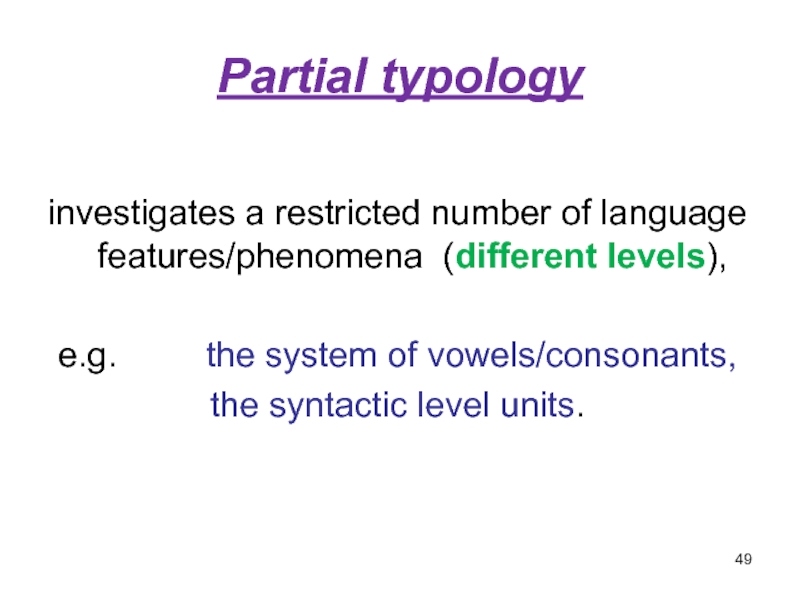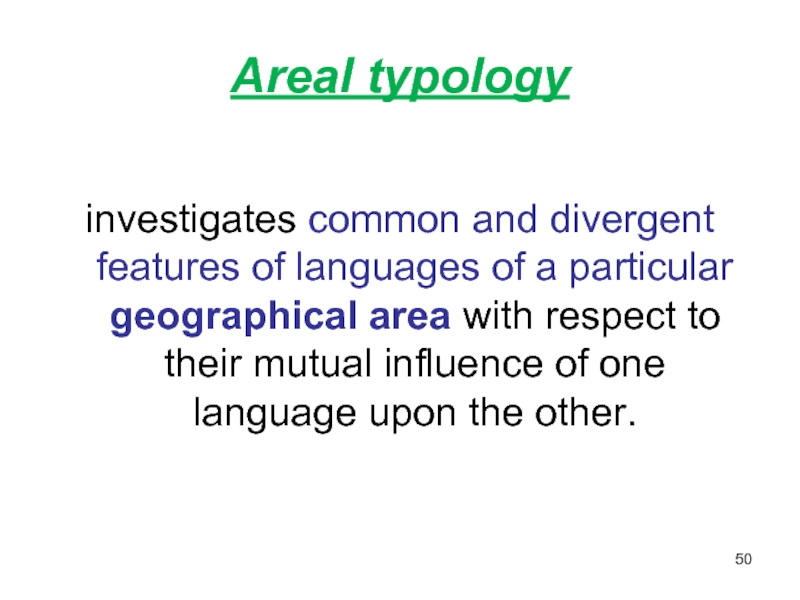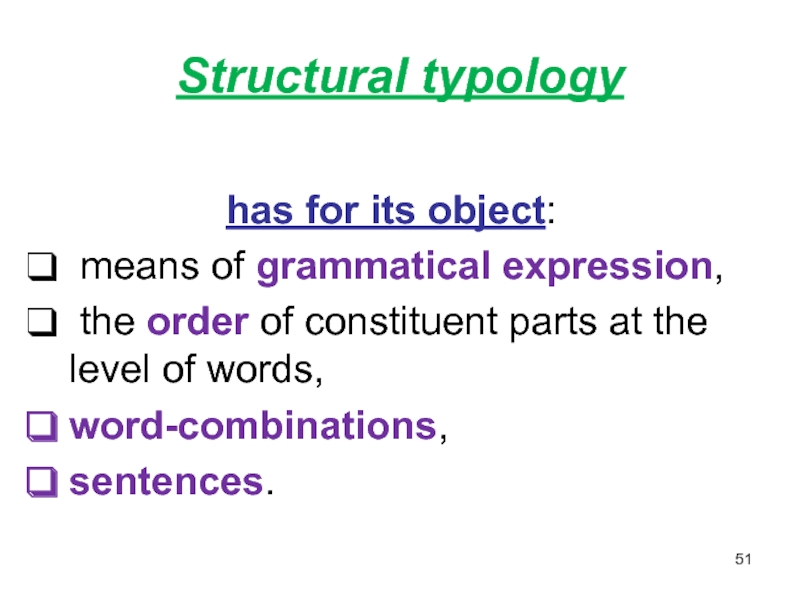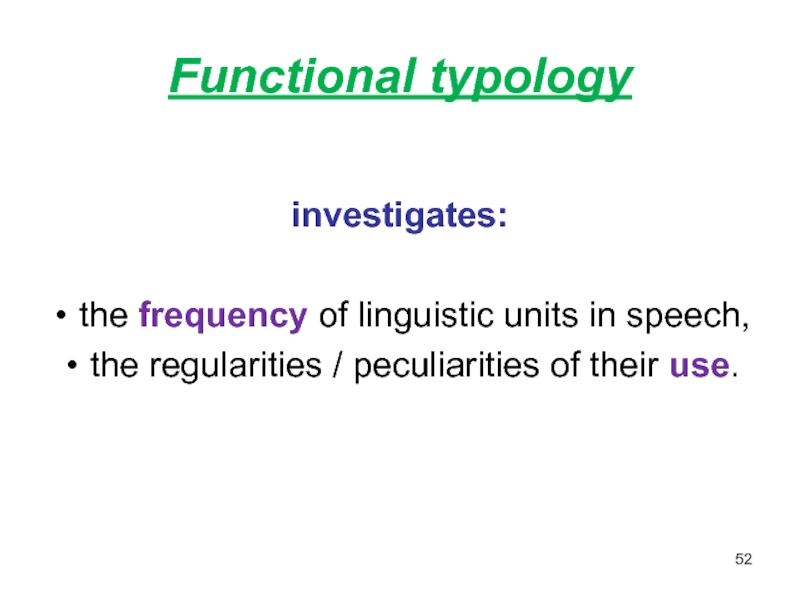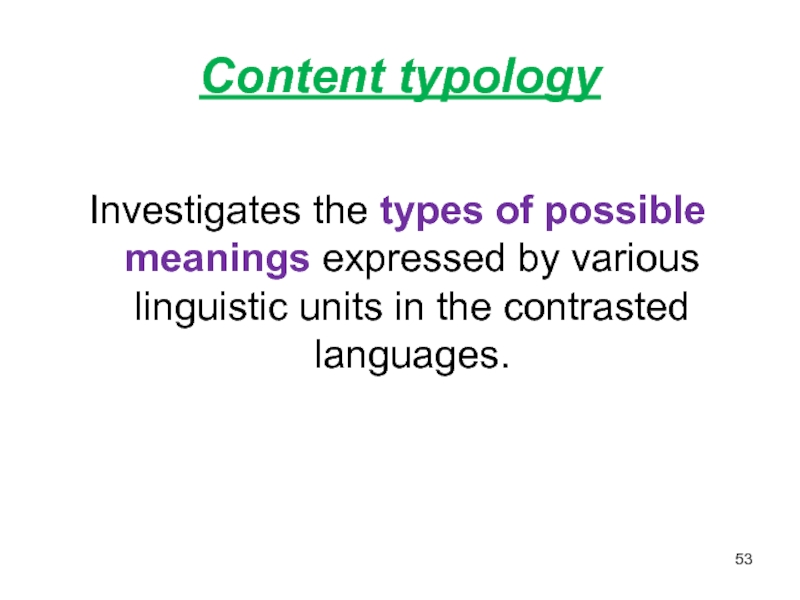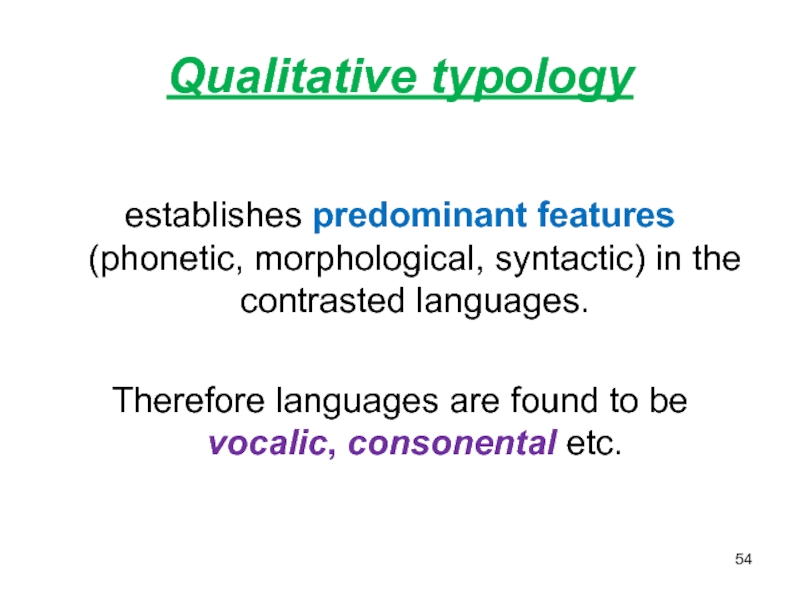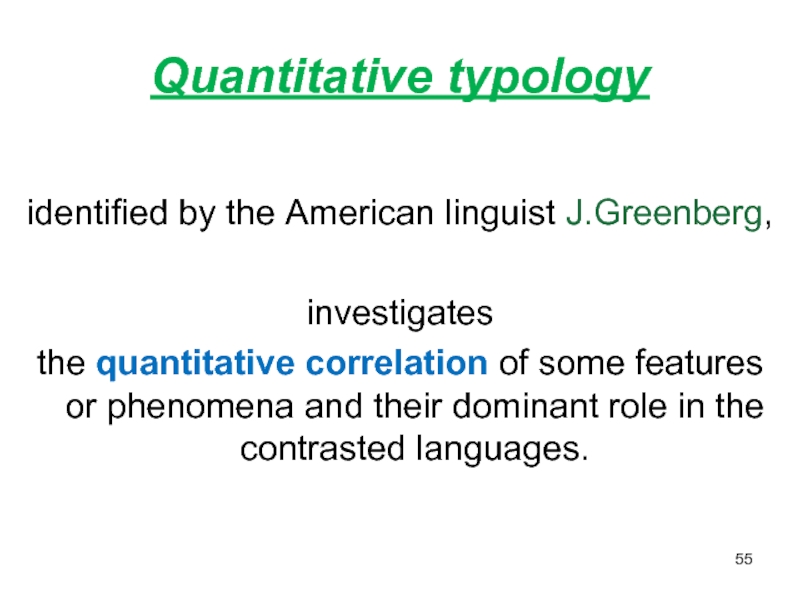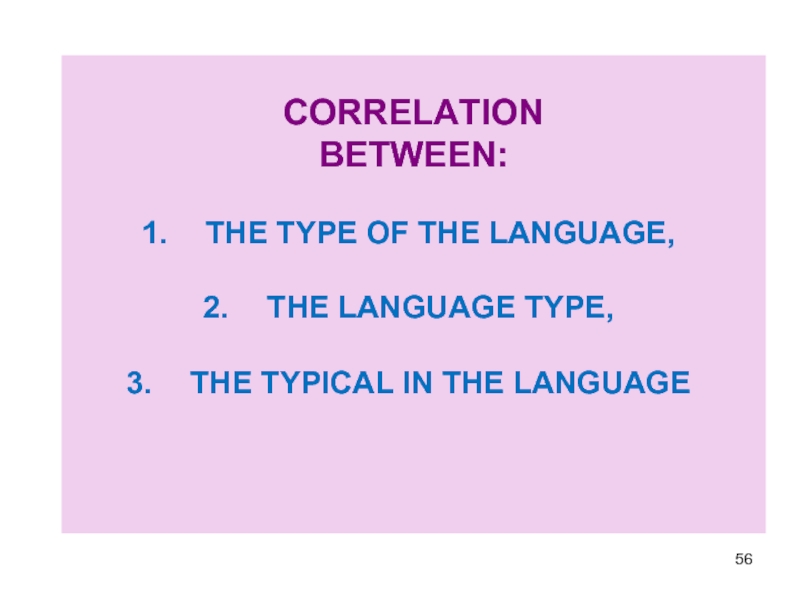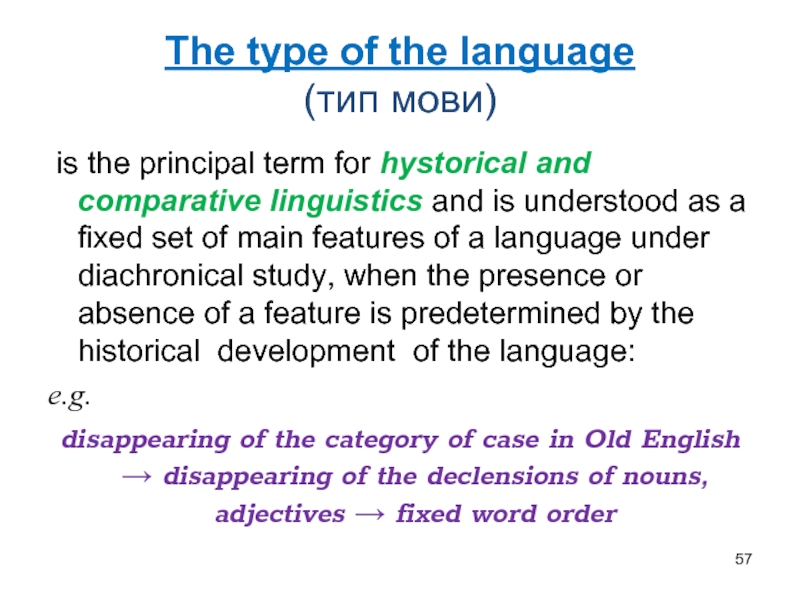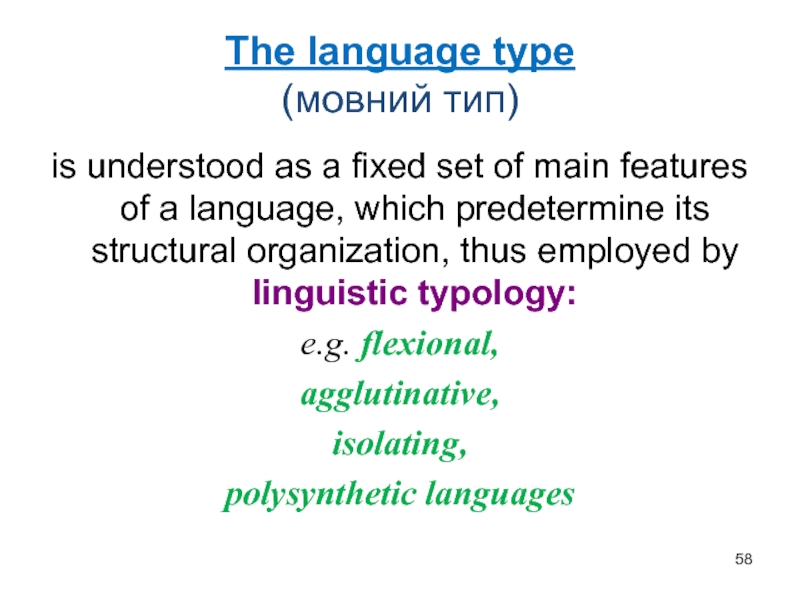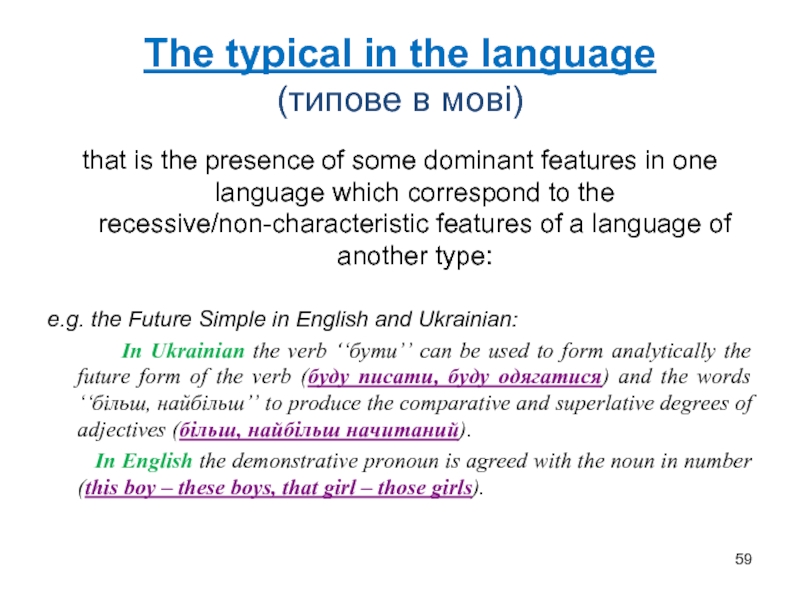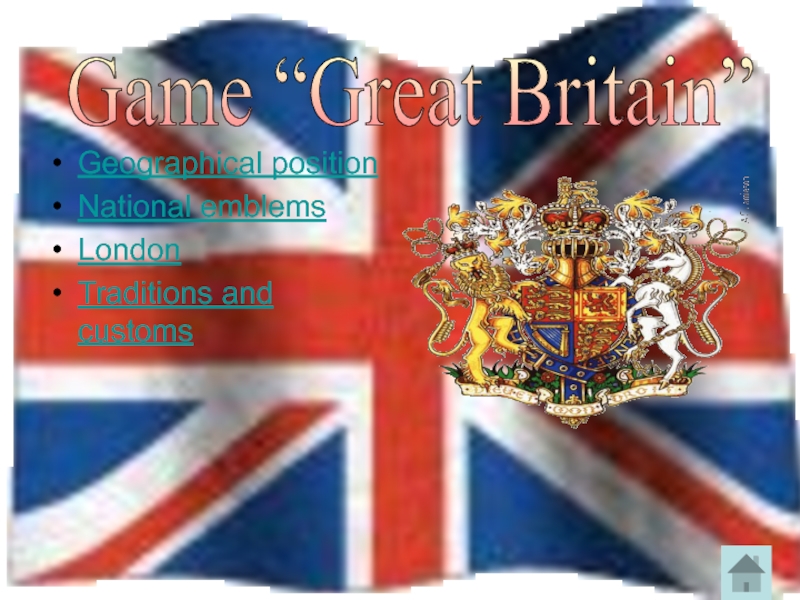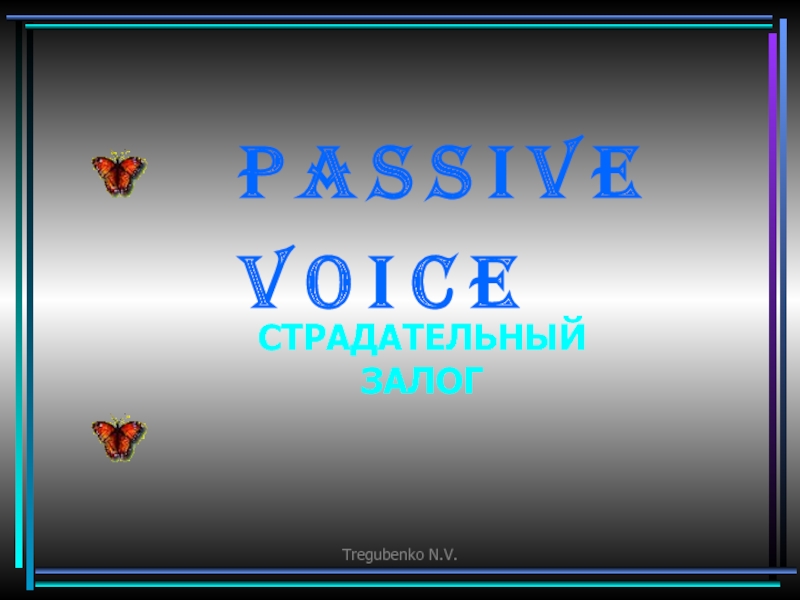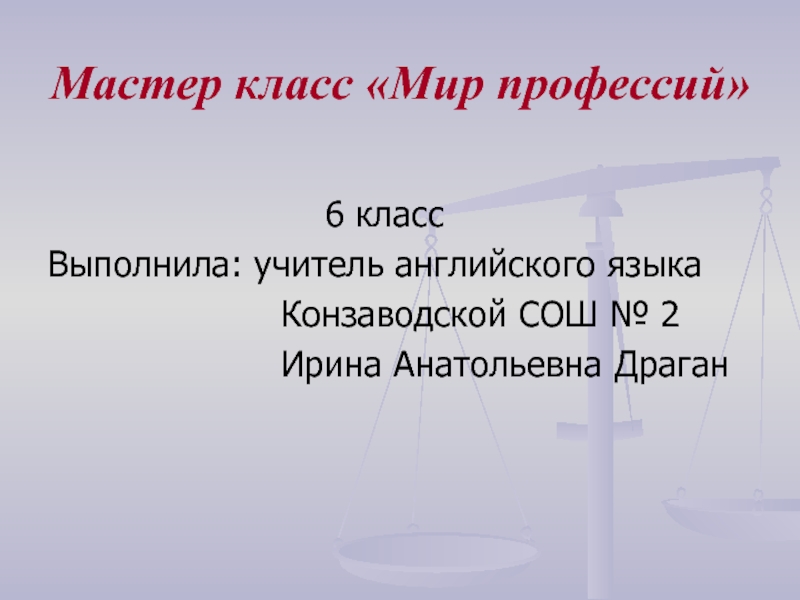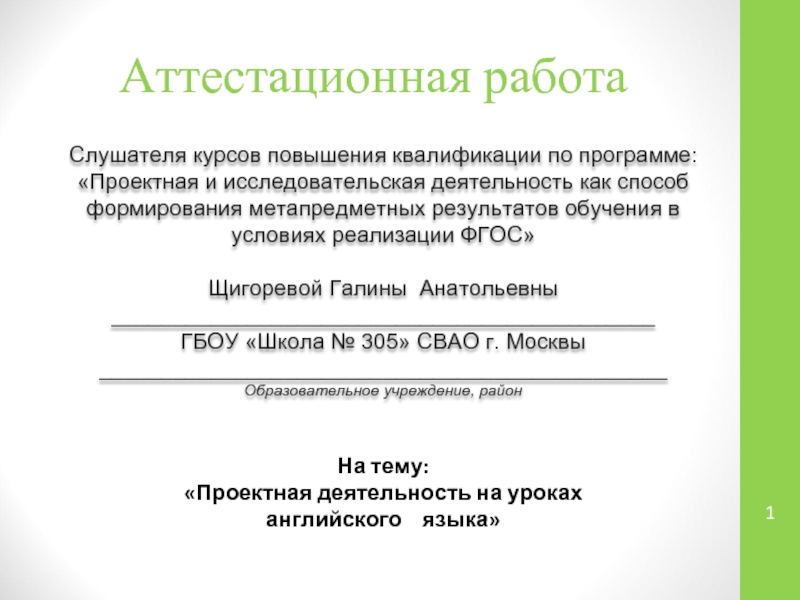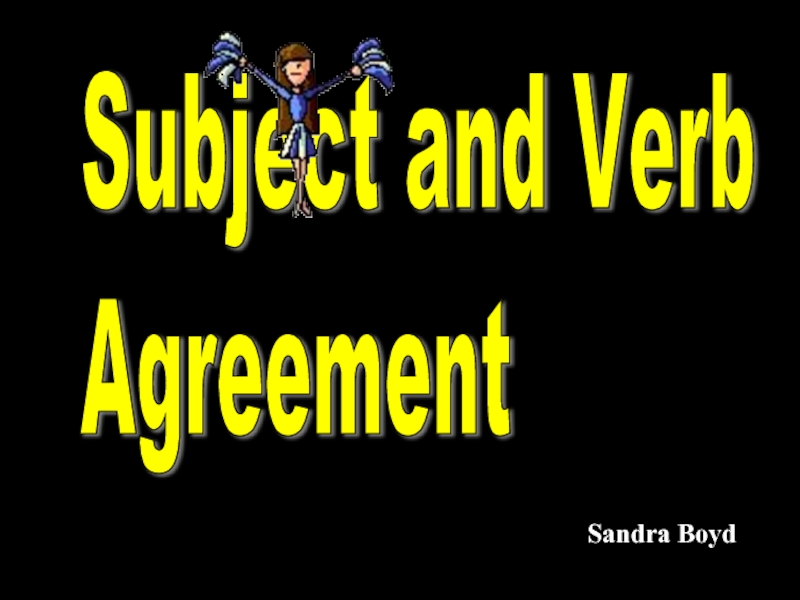OF THE ENGLISH AND
THE UKRAINIAN
LANGUAGES
- Главная
- Разное
- Дизайн
- Бизнес и предпринимательство
- Аналитика
- Образование
- Развлечения
- Красота и здоровье
- Финансы
- Государство
- Путешествия
- Спорт
- Недвижимость
- Армия
- Графика
- Культурология
- Еда и кулинария
- Лингвистика
- Английский язык
- Астрономия
- Алгебра
- Биология
- География
- Детские презентации
- Информатика
- История
- Литература
- Маркетинг
- Математика
- Медицина
- Менеджмент
- Музыка
- МХК
- Немецкий язык
- ОБЖ
- Обществознание
- Окружающий мир
- Педагогика
- Русский язык
- Технология
- Физика
- Философия
- Химия
- Шаблоны, картинки для презентаций
- Экология
- Экономика
- Юриспруденция
Contrastive typology of the English and the Ukrainian Languages презентация
Содержание
- 1. Contrastive typology of the English and the Ukrainian Languages
- 2. BASIC LITERATURE Аракин В.Д.
- 3. ADDITIONAL LITERATURE Волкова Л.М. Теоретична грамматика англійської
- 4. PRACTICAL ASSIGNMENTS (from Korunets 2003) Seminar
- 5. CONTRASTIVE TYPOLOGY, ITS AIMS AND TASKS. VARIOUS TYPOLOGIES
- 6. THE OUTLINE The object
- 7. The hypothesis of the unified language
- 8. The task the result
- 9. Different languages ‘‘Different languages are not different
- 10. Nomination
- 11. Modern tendencies A contrastive investigation of languages
- 12. Different studies Linguistic typology Historical and comparative linguistics Contrastive typology
- 13. Linguistic typology (the subject)
- 14. Linguistic typology is
- 15. The aim of Linguistic typology
- 16. ‘‘The language type’’ as the basic
- 17. e.g. Turkic languages (dominant features ) 1)
- 18. The object of any typological investigation (linguistic
- 19. The stages (aims) of typological investigations
- 20. Historical and comparative linguistics the
- 21. Contrastive typology Contrastive typology (порівняльна
- 22. The subject of contrastive typology
- 23. The оbject of contrastive typology
- 24. The final aims of
- 25. Practical aims of contrastive investigations
- 27. The number of investigated languages
- 28. The plane of investigation The languages
- 29. TYPOLOGICAL CONSTANTS (The notion of etalon language. Language universals and their kinds …)
- 30. TYPOLOGICAL CONSTANTS Absolute universals
- 31. Absolute universals features or phenomena
- 32. The absolute universals of the phonological
- 33. The absolute universals of the morphological level
- 34. The absolute universals of the syntactic level
- 35. Near universals features or phenomena common in
- 36. Typologically dominant features features or phenomena dominating
- 37. He will not dance. Future simple
- 38. English VS Ukrainian The change of placement
- 39. Typologically recessive features features or phenomena losing
- 40. Isomorphic features common features or phenomena in
- 41. Allomorphic features features or phenomena which are
- 42. Unique features features or phenomena which can
- 43. The etalon language a hypothetic language creatеd
- 44. Metalanguage the language on the basis
- 45. KINDS OF TYPOLOGICAL INVESTIGATIONS
- 46. Universal typology investigates all the
- 47. Special or charactereological typology usually investigates
- 48. General typology has for its object of
- 49. Partial typology investigates a restricted number
- 50. Areal typology investigates common and divergent
- 51. Structural typology has for its object:
- 52. Functional typology investigates: the
- 53. Content typology Investigates the types of
- 54. Qualitative typology establishes predominant features (phonetic,
- 55. Quantitative typology identified by the American
- 56. CORRELATION BETWEEN: THE
- 57. The type of the language (тип
- 58. The language type (мовний тип) is
- 59. The typical in the language (типове
- 60. The end To be continued…
- 61. Thanks for your attention!:)
- 62. HAVE A NICE DAY !!!
Слайд 2BASIC LITERATURE
Аракин В.Д. Сравнительная типология английского и русского языков /
В.Д. Аракин. – Л. : Просвещение, 1989. – 259 с.
Жлуктенко Ю.О. Порівняльна граматика англійської та української мов /
Ю.О. Жлуктенко. – К., 1960. – 160 с.
Корунець І.В. Порівняльна типологія англійської та української мов /
І.В. Корунець. – Київ : Либідь, 1995. – 238 с.
Корунець І.В. Порівняльна типологія англійської та української мов /
І.В. Корунець. – Вінниця : Нова Книга, 2003. – 464 с.
Левицький А.Е. Порівняльна граматика англійської та української мов :
Навчальний посібник / А.Е. Левицький. – К. : Видавничо-
поліграфічний центр: ‘‘Київський університет’’, 2008. – 264 с.
Слайд 3ADDITIONAL LITERATURE
Волкова Л.М. Теоретична грамматика англійської мови: Сучасний
підхід. – Навчальний посібник / Л.М. Волкова. – К. :
‘‘Освіта України’’, 2009. – 256 с.
Гуревич В.В. Теоретическая грамматика английского языка.
Сравнительная типология английского и русского языков /
В.В. Гуревич. – М. : Флинта, Наука, 2007. – 168 с.
Камчатнов А.М., Николина Н.А. Структурная типология языков //
Введение в языкознание. – М. : Флинта, Наука, 2008. –
229 c.
Мечковская Н.Б. Общее языкознание. Структурная и социальная
типология языков / Н.Б. Мечковская. – М. : Флинта,
Наука, 2008. – 312 с.
Практическая фонетика английского языка / М.А. Соколова,
К.П. Гинтовт, Л.А. Кантер и др. – М. : ВЛАДОС, 1997. – 384 с.
‘‘Освіта України’’, 2009. – 256 с.
Гуревич В.В. Теоретическая грамматика английского языка.
Сравнительная типология английского и русского языков /
В.В. Гуревич. – М. : Флинта, Наука, 2007. – 168 с.
Камчатнов А.М., Николина Н.А. Структурная типология языков //
Введение в языкознание. – М. : Флинта, Наука, 2008. –
229 c.
Мечковская Н.Б. Общее языкознание. Структурная и социальная
типология языков / Н.Б. Мечковская. – М. : Флинта,
Наука, 2008. – 312 с.
Практическая фонетика английского языка / М.А. Соколова,
К.П. Гинтовт, Л.А. Кантер и др. – М. : ВЛАДОС, 1997. – 384 с.
Слайд 4PRACTICAL ASSIGNMENTS
(from Korunets 2003)
Seminar 2 - ex. 4, 6, 8, 13,
15 pp. 112-115
Seminar 3 - ex. 1, 3, 7, 8 pp. 173-177
Seminar 4 - ex. 2, 6-10 pp. 276-280
Seminar 5 – ex. 2, 3, 5, 6 pp. 451-454
Seminar 3 - ex. 1, 3, 7, 8 pp. 173-177
Seminar 4 - ex. 2, 6-10 pp. 276-280
Seminar 5 – ex. 2, 3, 5, 6 pp. 451-454
Слайд 6
THE OUTLINE
The object and the subject of contrastive typology, its aims
and tasks.
Typological constants of contrastive typology.
The main branches of typological investigation.
4. Correlation between
1) the type of the language,
2) the language type,
3) the typical in the languages.
Typological constants of contrastive typology.
The main branches of typological investigation.
4. Correlation between
1) the type of the language,
2) the language type,
3) the typical in the languages.
Слайд 7The hypothesis of the unified language
UKRAINIAN ВОВК
RUSSIAN ВОЛК
BULGARIAN ВЪЛК
SERBIAN ВУК
CZECH ВЛК
POLISH WILK
LITHUANIAN VILKAS
LETTISH VILKS
GERMAN WOLF
ENGLISH WOLF
GOTHIC WULFS
ALBANIAN ULK
RUSSIAN ВОЛК
BULGARIAN ВЪЛК
SERBIAN ВУК
CZECH ВЛК
POLISH WILK
LITHUANIAN VILKAS
LETTISH VILKS
GERMAN WOLF
ENGLISH WOLF
GOTHIC WULFS
ALBANIAN ULK
Слайд 8The task the result
of typological investigations
If
we set ourselves a task to show up all regularities (закономірності) and singularities (відмінності) in the languages contrasted,
we’ll get a set of characteristics according to which we can distinguish one group of languages from another.
we’ll get a set of characteristics according to which we can distinguish one group of languages from another.
Слайд 9Different languages
‘‘Different languages are not different
designations of the thing, they are
different views
(impressions,
understandings)
of this thing’’
(W. von Humboldt).
Слайд 10 Nomination
English
Ukrainian
Spyhole вічко (рос.дверной глазок)
Bread-maker годувальник
To take a bus сідати на автобус
To lie in the sun загорати
Sweetheart кохана/ий
Brown bread чорний хліб
Granulated sugar цукор-пісок
Egg-plant баклажан
Spyhole вічко (рос.дверной глазок)
Bread-maker годувальник
To take a bus сідати на автобус
To lie in the sun загорати
Sweetheart кохана/ий
Brown bread чорний хліб
Granulated sugar цукор-пісок
Egg-plant баклажан
Слайд 11Modern tendencies
A contrastive investigation of languages has become one of the
most attractive areas of today’s linguistics (+contrastive pragmatics).
A contrastive study of languages is the research of different world pictures, unique linguistic cultures, ethnic peculiarities of perception of the environment.
A contrastive study of languages is the research of different world pictures, unique linguistic cultures, ethnic peculiarities of perception of the environment.
Слайд 12Different studies
Linguistic typology
Historical and comparative linguistics
Contrastive typology
Слайд 13Linguistic typology
(the subject)
1) Classification of the main,
essential features of languages and
2) revealing the linguistic regularities in them
Слайд 15
The aim of Linguistic typology
to provide the
classification
of the languages of different types, irrespective of their genealogical relationship
of the languages of different types, irrespective of their genealogical relationship
Слайд 16‘‘The language type’’
as the basic notion of linguistic typology
can
be understood
as the language structure with an accent
on its dominating features
as the language structure with an accent
on its dominating features
Слайд 17e.g. Turkic languages
(dominant features )
1) monosemantic and standard suffixes, so called
‘‘stickers’’,
2) a strictly prescribed order of suffixes etc.
(okul ‘‘школа’’,
okullar ‘‘школи’’,
okullarimiz ‘‘наші школи’’,
okullarimizda ‘‘в наших школах”)
These features are permanent for Turkic languages, so it is possible to contrast them to another group of languages.
2) a strictly prescribed order of suffixes etc.
(okul ‘‘школа’’,
okullar ‘‘школи’’,
okullarimiz ‘‘наші школи’’,
okullarimizda ‘‘в наших школах”)
These features are permanent for Turkic languages, so it is possible to contrast them to another group of languages.
Слайд 18The object of any typological investigation (linguistic or contrastive)
The object of typological investigation may be:
a separate language feature or phenomenon pertained to some genealogically close or genealogically far languages,
separate features, language units or phenomena pertained to both living and one or two dead languages,
language / languages.
Therefore, the object of typological investigation may be:
a restricted object of investigation or
an extensive language material
a separate language feature or phenomenon pertained to some genealogically close or genealogically far languages,
separate features, language units or phenomena pertained to both living and one or two dead languages,
language / languages.
Therefore, the object of typological investigation may be:
a restricted object of investigation or
an extensive language material
Слайд 19
The stages (aims) of typological investigations
to identify the main isomorphic
and allomorphic features characteristic of the languages under investigation;
to draw from these common or divergent features respectively the isomorphic regularities (закономірності) and the allomorphic singularities (відмінності) in the languages contrasted;
to establish on the basis of the obtained isomorphic features the typical language structures and the types of languages;
to perform on the basis of the obtained practical data a truly scientific classification of the existing languages in the world;
to establish the universal features pertained to each single language in the world.
to draw from these common or divergent features respectively the isomorphic regularities (закономірності) and the allomorphic singularities (відмінності) in the languages contrasted;
to establish on the basis of the obtained isomorphic features the typical language structures and the types of languages;
to perform on the basis of the obtained practical data a truly scientific classification of the existing languages in the world;
to establish the universal features pertained to each single language in the world.
Слайд 20Historical and comparative linguistics
the study about the genealogical kinship of some
languages, it aims at establishing the parent language;
it also studies the obligate changes in phonology, grammar and the word-stock of the daughter languages under investigation
it also studies the obligate changes in phonology, grammar and the word-stock of the daughter languages under investigation
Слайд 21Contrastive typology
Contrastive typology
(порівняльна типологія)
represents a linguistic subject of typology
based on
the method of comparison
or contrasting.
the method of comparison
or contrasting.
Слайд 22The subject
of contrastive typology
Like linguistic typology
contrastive typology also aims at establishing the structural types of the contrasted languages on the basis of their dominant or common phonetic, morphological, lexical and syntactic features.
Слайд 23The оbject
of contrastive typology
Apart from linguistic typology
contrastive
typology may equally treat:
common features only as well as divergent phenomena only;
languages of the same structural type as well as languages of different structural types.
common features only as well as divergent phenomena only;
languages of the same structural type as well as languages of different structural types.
Слайд 24
The final aims
of contrastive investigations
(two first points from
the aims of linguistic typology)
to identify the main isomorphic and allomorphic features characteristic of the languages under investigation;
to draw from these common or divergent features respectively the isomorphic regularities (закономірності) and the allomorphic singularities (відмінності) in the languages contrasted.
to identify the main isomorphic and allomorphic features characteristic of the languages under investigation;
to draw from these common or divergent features respectively the isomorphic regularities (закономірності) and the allomorphic singularities (відмінності) in the languages contrasted.
Слайд 25Practical aims
of contrastive investigations
to supply the ground for
translation theory and practice;
to foresee and overcome unnecessary interference of languages in teaching practice.
e.g. the cases taken from Nigel Turton. The ABC of Common Grammatical errors:
Слайд 27The number of investigated languages
The number of different
languages
which can be
simultaneously subjected to
typological contrasting
is not limited.
simultaneously subjected to
typological contrasting
is not limited.
Слайд 28The plane of investigation
The languages or some of their features /
phenomena may be contrasted
either synchronically
or diachronically.
either synchronically
or diachronically.
Слайд 29TYPOLOGICAL CONSTANTS (The notion of etalon language. Language universals and their kinds
…)
Слайд 30
TYPOLOGICAL CONSTANTS
Absolute universals (абсолютнi унiверсалiї)
Near universals (неповнi/частковi унiверсалiї)
Typologically dominant features (типол.
домiнанти)
Typologically recessive features
Isomorphic features (iзоморфічнi риси)
Allomorphic features (aломорфічнi риси)
Unique features (унiкалiї)
The etalon language (мова-еталон)
Metalanguage (метамова)
Typologically recessive features
Isomorphic features (iзоморфічнi риси)
Allomorphic features (aломорфічнi риси)
Unique features (унiкалiї)
The etalon language (мова-еталон)
Metalanguage (метамова)
Слайд 31Absolute universals
features or phenomena of a language level pertaining
to any language of the world:
vowels and consonants,
word-stress and
utterance stress,
parts of the sentences,
parts of speech etc.
vowels and consonants,
word-stress and
utterance stress,
parts of the sentences,
parts of speech etc.
Слайд 32
The absolute universals of the phonological level are:
in each language
CV syllable type can be found,
2) the consonantal minimal set comprises
plosives /p/, /t/, /k/,
fricative /f/ and
sonorant /j/.
2) the consonantal minimal set comprises
plosives /p/, /t/, /k/,
fricative /f/ and
sonorant /j/.
Слайд 33The absolute universals of the morphological level are:
1) in all languages words can be classified into parts of speech,
2) The most frequent noun category is the category of number,
3) the most frequent verb category is the category of tense,
4) in all languages pronouns are available.
2) The most frequent noun category is the category of number,
3) the most frequent verb category is the category of tense,
4) in all languages pronouns are available.
Слайд 34The absolute universals of the syntactic level
in any language there exist
the class of conjunctions,
2) constructions of comparison can be found in any language.
2) constructions of comparison can be found in any language.
Слайд 35Near universals
features or phenomena common in many or some languages under
typological investigation.
For instance,
1) in most languages there is a nasalized consonant,
2) in a great number of languages two vocalic phonemes can be found,
3) if the noun in a language can be characterized by the category of gender, the same category can be applied to analyze the pronoun.
For instance,
1) in most languages there is a nasalized consonant,
2) in a great number of languages two vocalic phonemes can be found,
3) if the noun in a language can be characterized by the category of gender, the same category can be applied to analyze the pronoun.
Слайд 36Typologically dominant features
features or phenomena dominating at a language level or
in the structure of one/some contrasted languages.
Analytical means
are known to be dominant
in present-day English.
Analytical means
are known to be dominant
in present-day English.
Слайд 38English VS Ukrainian
The change of placement of the part of the
sentence may completely change its sense:
e.g. The hunter killed the bear ≠
The bear killed the hunter
Compare in Ukrainian:
Мисливець убив ведмедя =
Ведмедя убив мисливець
NB case, gender and number categories in Ukrainian are expressed by means of inflexions (братові книги, він співав – вона співала ).
e.g. The hunter killed the bear ≠
The bear killed the hunter
Compare in Ukrainian:
Мисливець убив ведмедя =
Ведмедя убив мисливець
NB case, gender and number categories in Ukrainian are expressed by means of inflexions (братові книги, він співав – вона співала ).
Слайд 39Typologically recessive features
features or phenomena losing their former dominant role:
dual
number in Ukrainian:
вербá – вéрби (мн.) – 2,3,4 вербú;
case forms in English.
вербá – вéрби (мн.) – 2,3,4 вербú;
case forms in English.
Слайд 40Isomorphic features
common features or phenomena in languages under contrastive analysis.
Isomorphic
in English and in Ukrainian:
assimilation,
categories of number / person / tense,
parts of speech,
the existence of sentences etc.
assimilation,
categories of number / person / tense,
parts of speech,
the existence of sentences etc.
Слайд 41Allomorphic features
features or phenomena which are observed in one language and
missing in the other.
For example, English
Gerund,
Diphthongs,
Analytical verb forms
are completely missing in Ukrainian.
For example, English
Gerund,
Diphthongs,
Analytical verb forms
are completely missing in Ukrainian.
Слайд 42Unique features
features or phenomena which can be found only in one
definite language and nowhere else.
For example,
the final position of prepositions
in English questions.
For example,
the final position of prepositions
in English questions.
Слайд 43The etalon language
a hypothetic language creatеd by typologists for the sake
of conveniencies of contrasting any language.
This ‘‘language’’ is supposed to contain exhaustive quantitative and qualitative data or characteristics concerning all existing language units and phenomena.
This ‘‘language’’ is supposed to contain exhaustive quantitative and qualitative data or characteristics concerning all existing language units and phenomena.
Слайд 44Metalanguage
the language on the basis of which the actual presentation of
different features of the contrasted languages is carried out.
In our case it is English.
In our case it is English.
Слайд 46Universal typology
investigates all the languages of the world and aims
at singling out in them such features/phenomena which are common in all languages (absolute universals).
Слайд 47Special or charactereological typology
usually investigates concrete languages, as a rule the
native tongue.
The language on the basis of which the description of isomorphic and allomorphic features is performed is referred to as metalanguage.
The language on the basis of which the description of isomorphic and allomorphic features is performed is referred to as metalanguage.
Слайд 48General typology
has for its object of investigation the most general phonetic,
morphological, lexical, syntactic or stylistic features.
This typological approach was introduced by the German scholar
W. Humboldt.
This typological approach was introduced by the German scholar
W. Humboldt.
Слайд 49Partial typology
investigates a restricted number of language features/phenomena (different levels),
e.g.
the system of vowels/consonants,
the syntactic level units.
the syntactic level units.
Слайд 50Areal typology
investigates common and divergent features of languages of a particular
geographical area with respect to their mutual influence of one language upon the other.
Слайд 51Structural typology
has for its object:
means of grammatical expression,
the
order of constituent parts at the level of words,
word-combinations,
sentences.
word-combinations,
sentences.
Слайд 52Functional typology
investigates:
the frequency of linguistic units in speech,
the regularities /
peculiarities of their use.
Слайд 53Content typology
Investigates the types of possible meanings expressed by various linguistic
units in the contrasted languages.
Слайд 54Qualitative typology
establishes predominant features (phonetic, morphological, syntactic) in the contrasted languages.
Therefore languages are found to be vocalic, consonental etc.
Слайд 55Quantitative typology
identified by the American linguist J.Greenberg,
investigates
the quantitative correlation
of some features or phenomena and their dominant role in the contrasted languages.
Слайд 56
CORRELATION
BETWEEN:
THE TYPE OF THE LANGUAGE,
THE LANGUAGE TYPE,
THE TYPICAL IN THE LANGUAGE
Слайд 57The type of the language
(тип мови)
is the principal term
for hystorical and comparative linguistics and is understood as a fixed set of main features of a language under diachronical study, when the presence or absence of a feature is predetermined by the historical development of the language:
e.g.
disappearing of the category of case in Old English → disappearing of the declensions of nouns, adjectives → fixed word order
e.g.
disappearing of the category of case in Old English → disappearing of the declensions of nouns, adjectives → fixed word order
Слайд 58The language type
(мовний тип)
is understood as a fixed set of
main features of a language, which predetermine its structural organization, thus employed by linguistic typology:
e.g. flexional,
agglutinative,
isolating,
polysynthetic languages
e.g. flexional,
agglutinative,
isolating,
polysynthetic languages
Слайд 59The typical in the language
(типове в мовi)
that is the presence
of some dominant features in one language which correspond to the recessive/non-characteristic features of a language of another type:
e.g. the Future Simple in English and Ukrainian:
In Ukrainian the verb ‘‘бути’’ can be used to form analytically the future form of the verb (буду писати, буду одягатися) and the words ‘‘бiльш, найбiльш’’ to produce the comparative and superlative degrees of adjectives (бiльш, найбiльш начитаний).
In English the demonstrative pronoun is agreed with the noun in number (this boy – these boys, that girl – those girls).
e.g. the Future Simple in English and Ukrainian:
In Ukrainian the verb ‘‘бути’’ can be used to form analytically the future form of the verb (буду писати, буду одягатися) and the words ‘‘бiльш, найбiльш’’ to produce the comparative and superlative degrees of adjectives (бiльш, найбiльш начитаний).
In English the demonstrative pronoun is agreed with the noun in number (this boy – these boys, that girl – those girls).
